Royal
Rotterdam
Lloyd MS Sibajak 1928 to 1959
Please Note: Firefox &
some other Search
Engines may not be suitable
Use Google Chrome for this Web Page to load perfectly!

Click
the logo above to reach ssMaritime FrontPage & Featured ships
With
Reuben
Goossens
Maritime
Historian, Author, Lecturer & Cruise‘n’Ship
Reviewer
Please
Note: All ssMaritime and other related maritime
sites are 100% non-commercial and privately owned, thus ssmaritime is NOT
associated with any shipping company or any other organisation! Although the
author has worked and has been involved in the passenger shipping industry for
well over 60 years, but due to his old age and poor health, he was forced to
retire. Yet, he has completed well over 1,435 Classic Liners, Passenger-Cargo
Liners as well as humble converted C3 converted Migrant Liners, which has
transported countless thousands of folk to the new world, as well on
vacations’. I trust the features online will continue to provide Classic
Liner and Ship enthusiasts both the information they are seeking, but more so
provide a great deal of pleasure and relive many happy memories!!
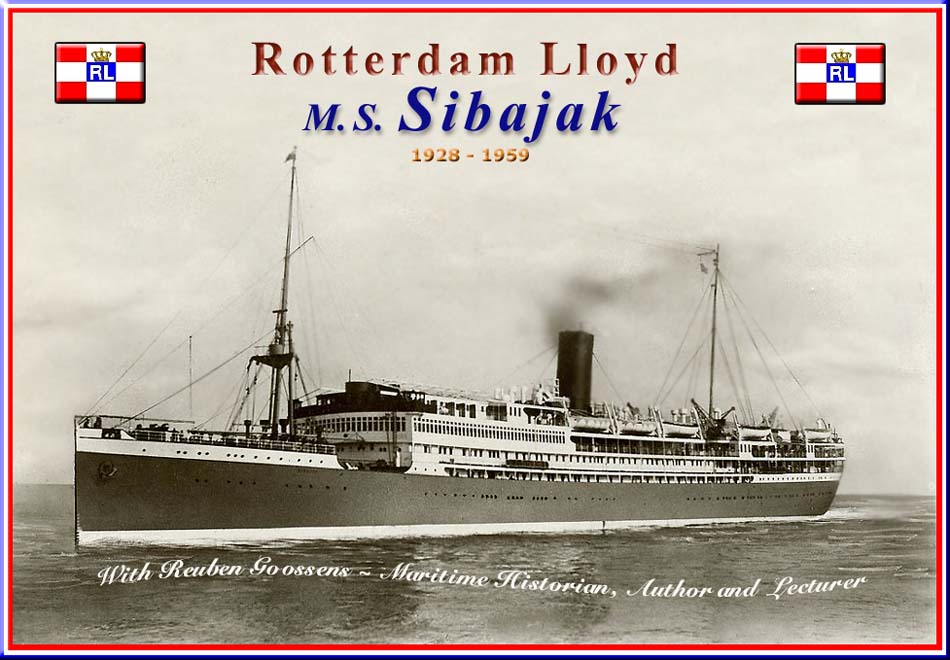
This
was the very first photograph that was officially released of the
Company’s
new Liner Sibajak and she is seen
here as built during her Deep Sea Trials
Page One
This Page is a NEW and a completely Updated Page
The Motor Ship Sibajak’s
History Page
By the Author of ssMaritime.com
Please
Note: Photographs on the MS Sibajak pages are mostly
from the author’s personal collection, unless otherwise stated!
However,
I wish to thank maritimedigitaal.nl for their kind cooperation!
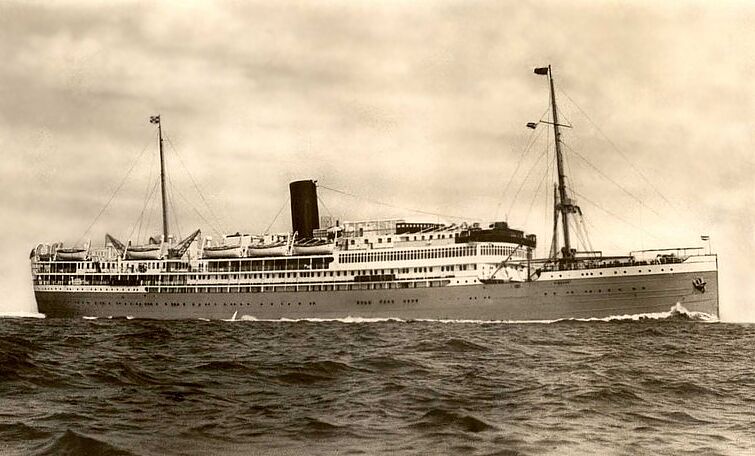
Here
we see the MS Sibajak after her having been refitted and note
that Sports Deck (topside forward)
has moved somewhat aft!
Introduction:
As
I commence, I wish to state that this is quite an extensive and a comprehensive
and a very large page with many photographs. The reason for this is that I
desired to add as much detail and history as possible regarding the MS Sibajak,
a ship that I personally greatly love and admire for it was this “Grand
Old Dame of the Sea” that was responsible for my decision to enter
working in the Passenger Shipping Industry in 1960 and eventually becoming a
Maritime Historian as well as a Cruise’n’Ship
Reviewer as many of you will well know! I certainly trust that you will enjoy
this, and the pages to follow.
N.V. Rotterdam
Lloyd
Background:
I personally believe it is always good to look
at the company’s background as well as the reason for them ordering of a
particular new ship, etc?
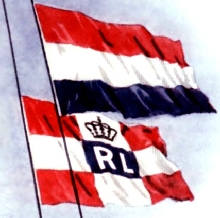 The
company started life in 1839 Named after it owner, “Willem
Ruys”
and commenced sailing ships trading mostly to the Dutch East Indies and the Far East.
In addition there were some voyages to South America.
In 1870 steamer service commenced to carry iron ore between Spain,
the Mediterranean and the Netherlands,
as well as a passenger and mail service to Batavia,
today’s Jakarta,
officially commenced in 1872. With the “Rotterdamsche
Lloyd,”
or “Rotterdam Lloyd” (RL) was officially formed in 1875.
The
company started life in 1839 Named after it owner, “Willem
Ruys”
and commenced sailing ships trading mostly to the Dutch East Indies and the Far East.
In addition there were some voyages to South America.
In 1870 steamer service commenced to carry iron ore between Spain,
the Mediterranean and the Netherlands,
as well as a passenger and mail service to Batavia,
today’s Jakarta,
officially commenced in 1872. With the “Rotterdamsche
Lloyd,”
or “Rotterdam Lloyd” (RL) was officially formed in 1875.
Then, after the World War 2, “Rotterdam
Lloyd” (RL) was granted the “Koninklijke”
or the “Royal” honour to its name and thus it became “Koninklijke Rotterdamsche
Lloyd” or in English, “Royal Rotterdam Lloyd” (RRL).
On June 1, 1923, the Kingdom
of The Netherlands
renewed its mail-contract with N.V. Rotterdam Lloyd (RL) and this contract
would see to the ongoing connections between The Netherlands and from the port
of Rotterdam
and its vital Far Eastern colony, being the Dutch East Indies.
Cargoes, Mail and Passengers would be safely
transported along the oceans of a good 9,200 nautical miles or 17.000
kilometres, along the ships regular schedules. The shipping company that was
prepared to take on the responsibility for such a major task was ensured of an
attractive financial contribution from the Dutch government as well as a
guaranteed supply of civil servants and military personnel for the passage to
and from the Dutch East Indies (known today as Indonesia).
In cooperation with the “Steamship
Company Nederland” from Amsterdam, the Rotterdam Lloyd would take care of
a weekly mail-service; One week there would be a departure from Rotterdam
sailing via Marseilles, and then the other week there would be a sailing from
Amsterdam sailing via Genoa and both would then head for Batavia and then
return to the Netherlands (Holland).
In order to meet future demands of the
mail-contract, RL at the end of 1924 drew up a long-range plan that included a
trio of new large (for those days) passenger liners, which together with the
two-funnelled 11,406 GRT (Gross Registered Ton) MS Slamat entered into
service in April 1924. She was followed by the slightly smaller single funnel
10,772 GRT MS Indrapoera and
she departed on her maiden voyage on February 10, 1926, and these two ships
with the largest liner of the trio already on order would constitute a new and
a modern RL fleet for the mail-service to and from the Dutch East Indies.
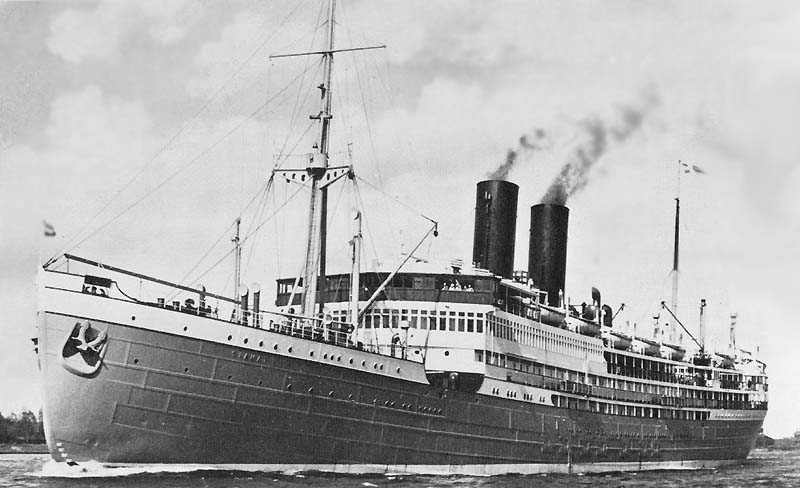
The
Rotterdam Lloyd MS Slamat was the first of the trio, but the only one built
with two funnels
The full trio of the Rotterdam Lloyd’s
new liners would ultimately be complete with the completion of the M.S.
Sibajak. However, she was followed by two much larger liners only several
years later, the first being the 16,981 GRT MS Baloeran, which departed for her
maiden voyage on April 15, 1930. The second of the pair was the 16,979 GRT MS
Dempo that departed on her maiden voyage in March 1931.
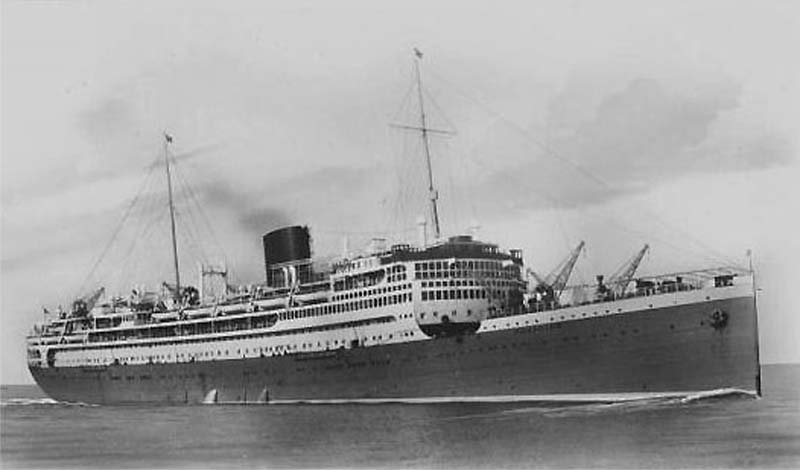
Here
we see the larger MS Dempo of 1931, identical sister of the Baloeran completed
one year earlier
See
the ‘Sibajak’ and the ‘Rotterdam Lloyd’ Index at the
bottom of this page
However it is important to note that it is the
Sibajak that is covered in this special “M.S.
Sibajak Feature” and although I am
currently doing an extensive update on this feature, I am no longer writing on
any further ships in the future, for I am so sorry, but for certain
circumstances I was forced to retire!
Reuben Goossens.
Building the MS Sibajak:
On
May 27, 1925 the Rotterdam Lloyd gave the Royal Company “De
Schelde” (KMS) that they would
require the Mail Ship “Sibajak” to be built, which was confirmed on
the 29th, when the ship was officially commissioned. Then on November 18, the
“Sibajak-contract” was finally signed by the two directors of KMS
at Vlissingen
and sent to RL Rotterdam completing the official acceptance of her building
procedure.
Seven days later one of the Directors for
Willem Ruys & Sons (RL) in Rotterdam,
most likely Mr.
B.
E.
Ruys
ratified the Vlissingen
contract.
However, there was an alteration as noted as
shown in Article 1 of the “Sibajak contract” was: De Schelde
undertakes, for Rotterdam Lloyd to build a “Steel-Double Screw Engine
Passenger Liner,” in regard to the interiors and equipment she should be
similar to the M.S. “Indrapoera,” according to her principal
dimensions, description and conditions, but including the additional work to be
carried out. She would be at an agreed cost of f6.8 million Dutch Gulden.
There had been a long tradition of cooperation
between RL and KMS, in fact since 1882 and during 65 years they had produced a
long series of beautiful ships for which their style showed certain outward
resemblances.
Her Design Features:
When
commissioning to build the Sibajak, RL being very wise due to many decades of
operational experience, gave special orders in relation to the construction of
the ship that she was to have all the characteristics of a mail-ship, but to be
suitable for the tropics. This meant that she had to have ample open and airy
decks, with surfaces large enough for the numerous deckchairs as well as for
vast promenades; elegant lounges with high ceilings and large windows in order
to allow as much light and fresh air as possible. In addition, all cabins had to
be located on the outside of the ship and the interior decoration was to be
both stately and comfortable in order to make the long voyage as enjoyable as
possible, but there were no particular concerns in relation to the ships speed.
In July 1926, RL decided that the interior
design of the Sibajak would be entrusted to the creative skills of the
well-known Mr.
H.P.
Mutters
who would work together with the “Royal Dutch Furniture Company.” The Hague
company “Mutters & Son” the Rotterdam
Lloyd
(RL) already had a long-standing and constructive relationship as they had
worked on their other ships. RL management not only had an eye for the
accommodation and the artistic interiors, but also the installations of new
technical equipment required not just their attention, but also great
expertise. RL wanted the Sibajak to be a “state of the art” Liner!
This also included the matter of the ship's eventual tendency to show yawing.
Such a tendency was particularly relevant for certain parts of the sea can be
anticipated, where there could well be heavy swells and storms, which would
make the passengers’ on board quite uncomfortable if not miserable. Thus
RL acquainted them selves with what was then a technical novelty: the
stabilizing tank. This was a large tank construction to be built into the lower
part of the ship which, because of the inertia of the fluid it contained (oil
e.g.) produced a buffing counter-force to the ship's annoying yawing movements.
As an experiment, the RL decided on April 7 1926 to have such a stabilizing
tank built into their Sibajak. Another novelty (at least for RL vessels) was
the installation of two electrical passenger lifts in the First Class section.
Moreover, at a later stage, with the building of the Sibajak having already
begun, RL management decided on August 19, 1926 to build in, as an experiment,
an underwater-clock signal that was to be used for echo sounding.
Construction:
But
it was on Saturday March 13, 1926 De
Schelde officially laid her keel of yard
number 181. During the twelve months and three weeks that followed, the
complicated building process took shape, resulting in the ship's hull with its
intricate unity of frames, bulkheads, deck and the hull plates. Once the hull
was closed, her deckhouses and other superstructures appeared up on the main
deck.
Photograph’s during her Construction
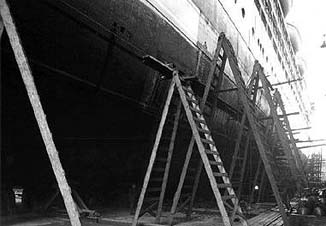
As
we look towards her aft, we can see that she is nearing completion
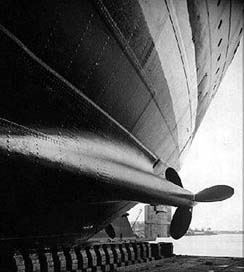
A
fine view of her port side propeller
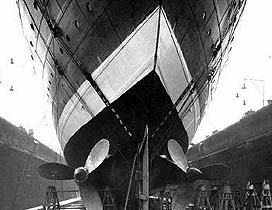
However
here we see her stern and both her propellers as well as her rudder
Her Launching:
Then
on Saturday April 2, 1927 with the hull construction having progressed enough
the new RL Liner was ready to be launched. On that day with her hull, painted
in the stylish RL house colours of what is known as “Dove Grey” and
“White,” she looked simply splendid. Along the quays sides many
invited guests had gathered to witness the ever-spectacular moment of the
launching of such a large ship. For, in the eyes of the Dutch, a 530 feet long
Liner was a giant indeed! At the inauguration ceremony she was officially
christened by Mrs.
T.
Mees-Bouvin
and named “Sibajak” after the mountain “Sibajak,” one
of the most beautiful on the island
of Sumatra,
the name meaning “The Rich One.” Her launching was a huge success
and once afloat she was towed to the “De
Schelde” fit-out berth for
completion.
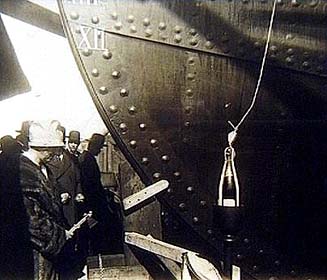
The
Sibajak’s is about to enter the water and here
we see Mrs.
T.
Mees-Bouvin
who has just cut loose
the bottle of champagne, as she had
been given the great honour to officially name and launch the Lloyd’s
Flagship!
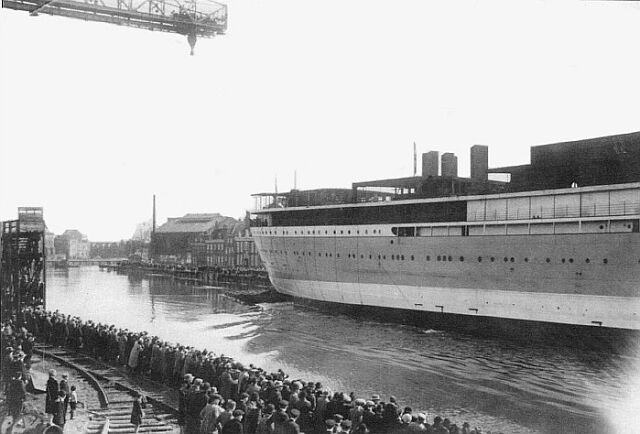
Here
we see the massive crowds watch as the Sibajak gently slips into the water
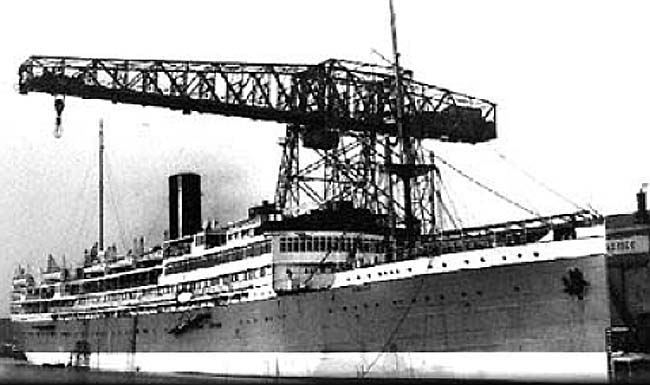
The
Sibajak is seen here at “De
Schelde” shipyards and her fit-out
berth
After her launch, they moored Sibajak
alongside the North quay of the yard basin, next to the imposing engineering
works. Within, good progress had been made on the construction and assembly of
the various motor-parts for the new ship. The Sibajak was provided with a pair
of 8-cylinder Schelde-Sulzer diesel engines with a total capacity of 10,000
shaft-horsepower. Those would enable the vessel to a service speed of 17 knots.
In the machine factory the parts of these engines were assembled into hulks of
roughly 49 feet long, 33 feet high and 12 feet deep. They also provided the
ship with three auxiliary units, which were likewise Schelde-Sulzer diesels
with 5 cylinders; these were to drive three huge generators, which provided for
the ship's electricity. Whilst in the ships interiors frantic work was at hand
by many carpenters, painters, furniture makers and upholsterers, as well as
plumbers and electricians completing the enormous work of realizing the various
interior designs as well as the galley’s.
The Sibajak heads
off for her Deep-Sea Trials:
January
2, 1928 was nothing short of a horrid and a bleak day complete with a
snowstorm, yet the Sibajak sailed from Flushing
to commence her first technical deep-sea trial. At the helm was one Rotterdam
Lloyd’s finest specialised Captains and with him one of the Maritime
Inspectors who kept an eye on the ship during her deep-sea trials. There were
several trials, and during these trials she reached an average speed of 16.59
knots, but a top speed of 17.65 knots, which was an excellent result. Her last
sea trial was on January 12 on a better weather day and she had handled perfectly
having had a small number of minor modifications made.
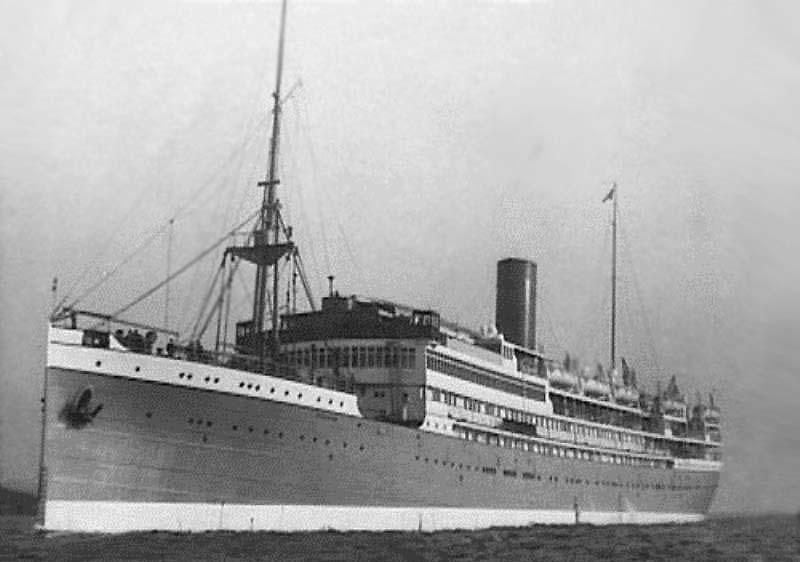
Here
we see the Sibajak completing her deep-sea trials on January 12, 1928 note aft
of the Bridge and officers cabins, as well as
the three windows for the covered
first class promenade deck. This is relevant and will be covered in the
deck-by-deck item!
On Saturday January 28, 1928 the MS Sibajak
was officially transferred by the shipyard to the Rotterdam Lloyd but this was
done by the means of special trial voyage with invited passengers.
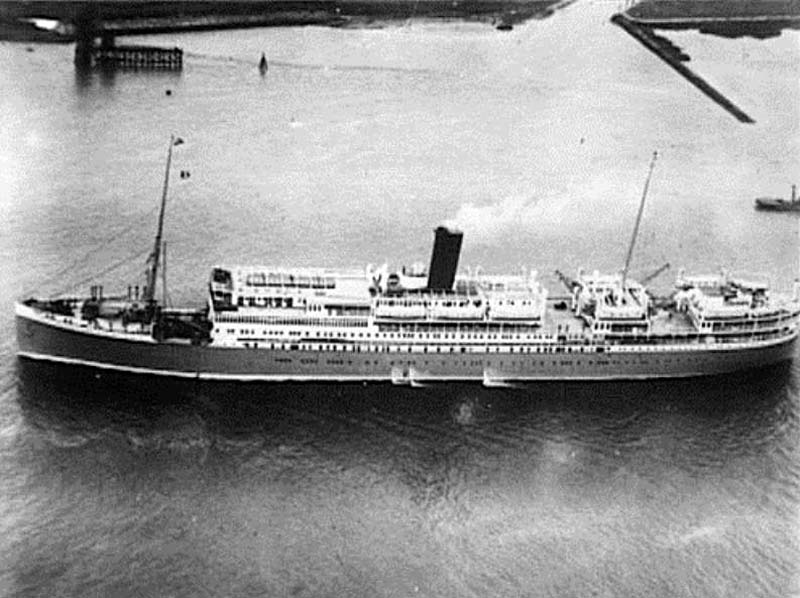
The
Sibajak is seen here on her Special trial Voyage on January 28, 1928
This voyage would test the working systems of
the ships chef’s, galley staff and service in the Dining Room as well in
the lounges and in the cabins, etc. The passengers list was obviously a
who’s who of the travel and shipping industry, and the ship certainly
received rave reviews after her short voyage.
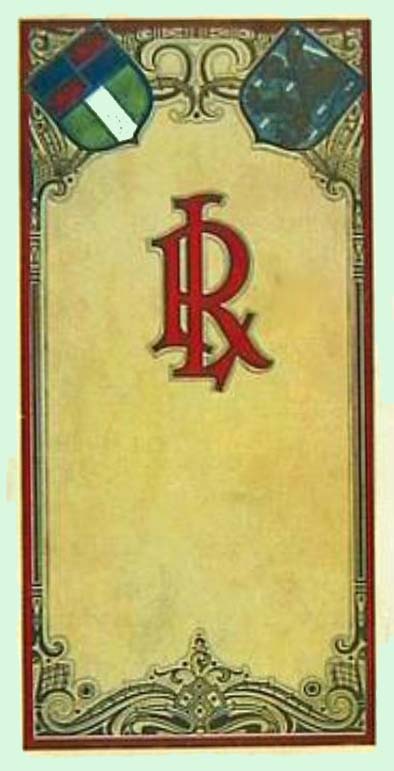
The
cover for the Passenger List for the special January 28 Trail mini-voyage
Now the completed MS Sibajak, the brand new
flagship of the Rotterdam Lloyd headed for Rotterdam
where she moored at the company’s berths where she was fully stocked,
manned and prepared for her maiden voyage as a RL Passenger Liner.
MS Sibajak’s Maiden Voyage to Batavia:
On Sunday February 8, 1928 with the Sibajak
being under the command of Captain W. J. Boon was ready for her big day.
Passengers had slowly gathered and boarded whilst relatives and friends waited
ashore to see the ship sail and wave them goodbye as the band played, for a
ships departure was such an emotional affair!
The Sibajak departed Rotterdam
and headed for the East Indies, sailing via Southampton,
Lisbon,
Tangier, Gibraltar, Marseilles,
Port Said,
Suez,
Colombo,
Sabang, Belawan,
Singapore
to Batavia
(Jakarta).
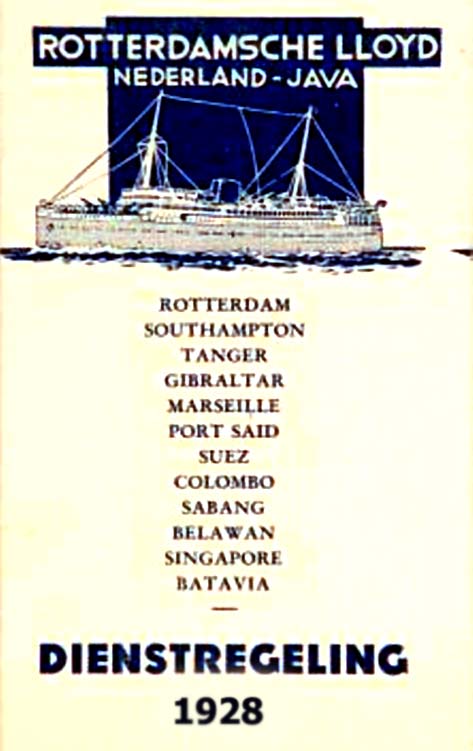
However,
towards Tangiers the Sibajak suffered a most severe storm that gave her huge
testing, for she was tossed to and fro, even causing a few portholes to be
smashed as well as a large ventilation shaft being knocked down.
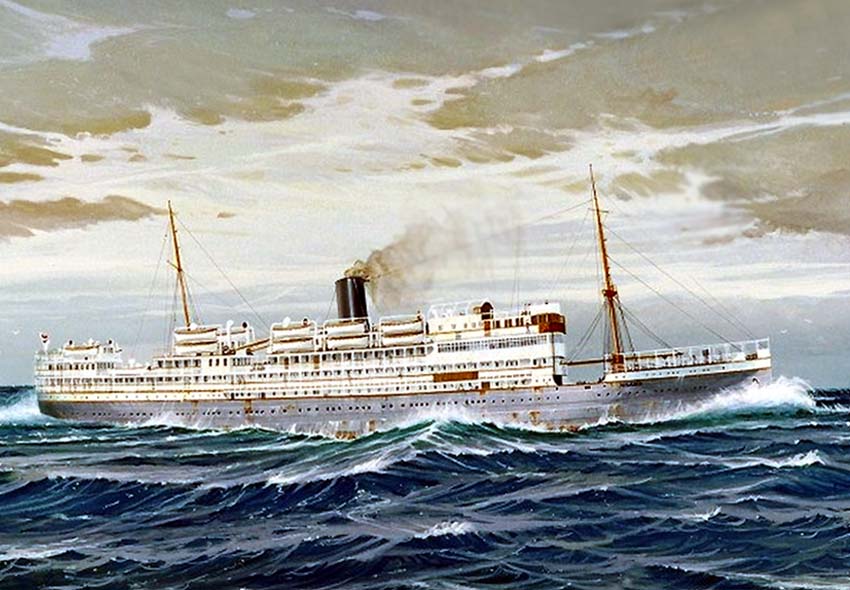
A
painting of the Sibajak during her maiden voyage and the storm she encountered
The artist is unknown - Please see Photo Notes at the bottom of
the page!
Once
the ship finally came out of the storm, it was reported that some “eleven
tables and twenty-three chairs” were completely damaged.
When the Sibajak had reached Tangiers a good
480-invited visitors boarded the ship during a special reception, during which
Captain Boon was appointed “Officer in the Sheriffian
Order” of the “Quissam
Alouette.”
This was a huge honour, considering that he had been to this port many times
and he was very highly regarded!
In Marseilles
a party of new passengers embarked, for they had travelled over land and thus
'cut-off' part of the sea route to Dutch East Indies
by taking a special boat train, named the Rotterdam Lloyd “Rapide.”
The MS Sibajak then sailed for Port Said
and then through the Suez Canal to Suez
after which she headed for the port
of Colombo
in Ceylon
(today’s Sri Lanka).
Here the passengers were allowed to go on shore leave and enjoy the warm
weather. Next was the beautiful and natural Harbour
of Sabang,
where the passengers encountered genuine tropical conditions for the first time
for it was very hot and humid. There was a band ashore and the Governor of Atjeh had come to the ship to make her especially welcome
to the port. Sibajak then sailed via Belawan and Singapore
to the port
of Tandjong Priok,
being the port
of Batavia
(Jakarta).
Here the majority of passengers disembarked, but some continued their journey
on board on the ship’s coastal voyage towards Soerabaja
(Surabaya). However, having
returned to Tandjong
Priok
on March 9, 1928 the Sibajak received the honour of a special visit by the Governor-General
De
Graaf.
On her return voyage to Rotterdam
the Sibajak held a special reception whilst she was in Singapore
in honour of the British Governor and there were 200 special invited guests.
Finally on April 24, 1928 the MS Sibajak returned from her circle Maiden Voyage
in Rotterdam
and Captain Boon was extremely happy with his ship as she had little to no
vibrations and her engines had performed perfectly in all conditions!
******************************
The Ships Layout and Facilities:
Now we have read all about her round maiden
voyage and her adventures with storms and special events welcoming her, etc, it
is time we discover a little regarding her interiors. As built she had
accommodations for just 427 passengers, with 212 in First Class, 174 Second
Class and 68 in Third Class. In addition to these, there were another 25 berths
reserved for Dutch Troops or Marines who would sail to and from the Dutch East Indies.
Although I sailed after she had
a number of refits and by then a One Class Liner, but as I recall even as a boy
how luxuriant the ex First Class Lounges the social Hall and Smoking Room were,
as there were the abundant luxuriant timbers and the huge bowed windows
offering fine views out to the Promenade deck as well as allowing light to
stream in.
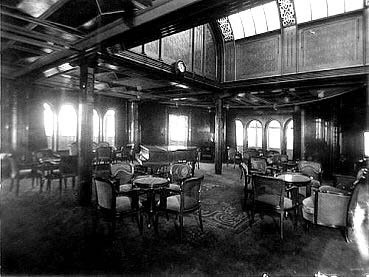 -
-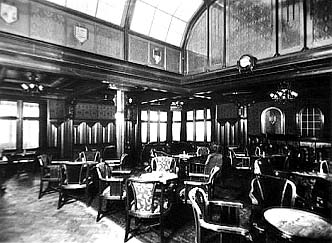
Here
we see two images of the grandiose Social Hall with its huge glass dome
The Forward Dining Room was also amazing and a
sight to behold and certainly not something that I as a boy could have
expected. It could be reached by a grand staircase, but also by two fully
attended electric lifts that featured the most beautifully Art Nouveau designed
glass and sculptured iron artwork lift doors that I have ever seen on any lift
to this date! But when you were in dining the room, which was simply beautiful,
but when you looked up it really hit you, for the venue reached up another two
full decks with the balustrades having been especially made from finely worked
decorative metal and it looked spectacular! The decks above were cabin decks
and the cabins located along the balustrades were the best of the first class
cabins and obviously had an amazing view as they stepped out of their rooms!
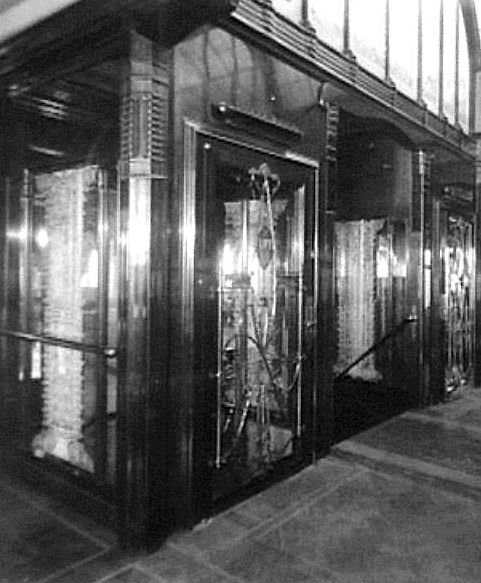 -
-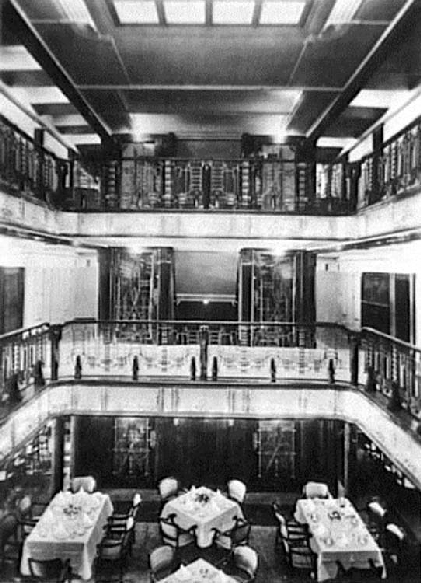
Here
we see the Lift Doors and the forward (First Class) Dining Room
However, the Second Class Public Rooms were
also amazingly beautifully appointed, such as the Smoking Room that had
beautifully balanced lines as well featuring the finest of timbers and it had a
luxurious feel and an excellent atmosphere. The furnishings were of a high
standard and on both sides there were large square windows overlooking the
Promenade Deck! Just aft on the portside the was a smaller lounge, called the
“Dames Salon,” or the “Ladies Lounge” yet it had
writing desks, and a piano as well as comfortable furnishings and I believe
that it was used as a general venue. Their Dining Room was well fitted out and
always looked beautiful.
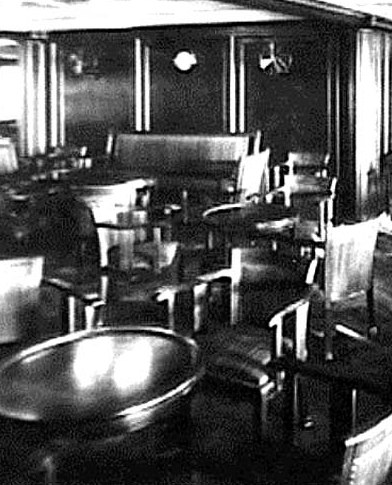 -
-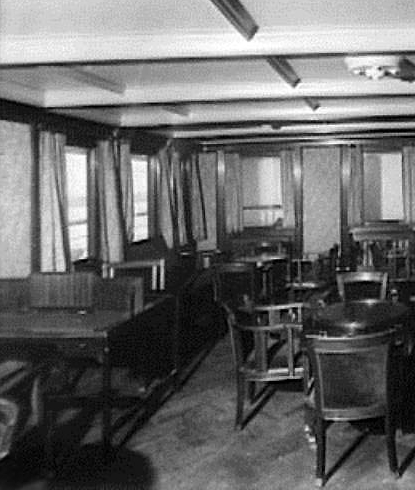
Left
we see part of the Second Class Smoke Room which is on A Deck
There
is a smaller Lounge on the portside, which has piano, comfy lounges,
A
good number of tables and chairs as well as writing desks
Far aft was the Third Class Promenade Deck
with its very spacious Sun Deck above but set in the middle of the deck was the
Smoking Lounge that had this Class’ main stairwell right in it’s
center of the Lounge. The Smoking Room had benches along the sidewalls and
tables and chairs where space allowed.
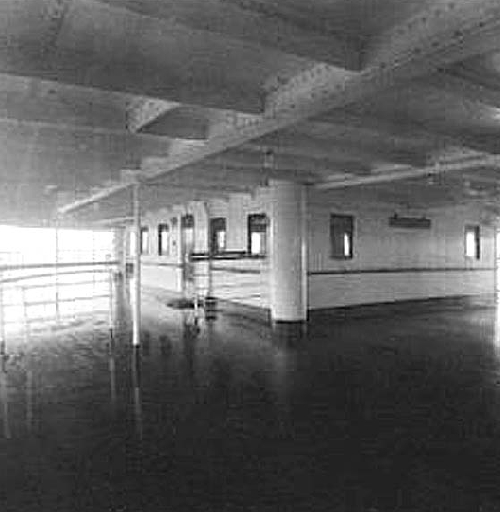 -
-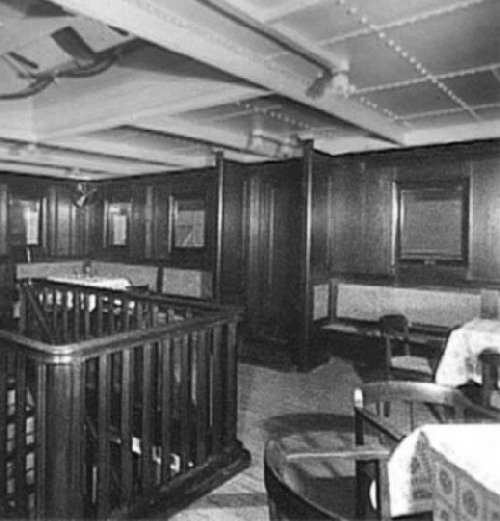
Here
is an overview of the 3rd.class Promenade Deck and the Smoking Room located in
the centre, and we also see the interior
Please
note that full sizes on the six images shown above will be shown on the
Interior Page for these images do the venues no justice!
Please Note: A full description of the Sibajak’s “Deck by Deck” layout, combined
with an extensive description of public venues and passenger facilities will be
provided on a special page that will also contain many wonderful vintage
photographs, which will do her far greater justice than what I have shown above
in these cropped images!
Back to her History
and Voyages:
The Sibajak departed Rotterdam
for her second voyage to Batavia,
but during this voyage the Captain did record in his log that during a
“stiff monsoon the ship did not deflect more than 8 degrees.”
However during her return voyage, whilst she was transiting the Suez Canal
for some reason the Sibajak sheered out of line and she bumped into the bank.
However, the Captain was able to free her rapidly and she could continue as no
damage was done. Apparently this kind of incident did happen occasionally with
other ships as it was said in those days that it would “with these large
ships crossing the relatively narrow channel.” Of course today, she would
be considered as being a rather small passenger ship and navigation and
practices are far further advanced!
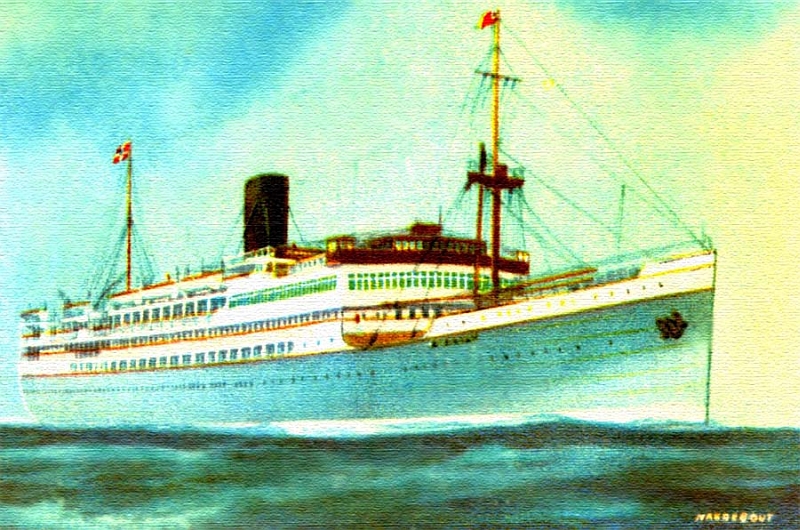
A
fine painting of the MS Sibajak seen as built
By & © Dutch artist Mr.
G.
J.
Frans
Naerebout
The
third voyage of the Sibajak was all plain sailing, although whilst heading for Batavia
she encountered one of the two sections of the then “worlds largest
dry-dock” that was on its way from England
to Singapore.
The dock was under-tow by a Dutch tug owned by the famed tug company of
“L. Smit & Co., International Towing
Services.” The truth is that British towing companies were not able to
perform this massive undertaking, but the Smit Deep
Sea tugs have become world famous and undertake countless massive towing jobs
and they continue to this day!
Sickness at Sea:
On
Sibajak’s Voyage number six, during her return
voyage a newspaper in the Dutch East Indies published an article that a
“Case of Smallpox discovered aboard the MS Sibajak.” The truth is
that on board of mail ships such as the Sibajak, the staff are always meticulously
on alert in case of any sickness on board especially in the tropics, as there
are contagious diseases always around.
Obviously influenza, measles and chicken pox
were some of the most fearsome enemies. Ship's personnel were always very
attentive to a cough or a red blotch. As soon as any suspicion of an infectious
illness arose, the patient would be immediately placed into isolation, which
would be a forced stay in their cabin or in the ship’s isolation sickbay.
In this particular instance, it turned out that it was a case of crewmember
smallpox had manifested itself towards the end of the outward journey and the
ship's doctor placed him in isolation. Thus the ships medical staff would do
everything in their power to control the situation that would arise and the
ship would advise the next Port Authority prior to arrival if certain
sicknesses were found on board! Thus it was not long after the illness had
manifested, the crewmember was taken off the ship and hospitalised in the Dutch
Indies before the ship commenced her return voyage for Rotterdam.
The first job the crew undertook would be to thoroughly clean and disinfect the
sick crewmembers quarters and as this crewmember had not been in contact with
passengers at any stage whatsoever, the passengers were never in any of the
danger and the newspaper did make this clear.
Of course the other thing in those days was
the occasional stowaways that were found on the ship. Thus after the departure,
especially from Asian ports, the crew staff would always keep a close eye on
whether someone had slipped and hidden somewhere aboard. On the return leg
Voyage number eight to Rotterdam they did discover a stowaway, who was put
ashore in Singapore, but he was looked well after whilst he was on board for
the next few days.
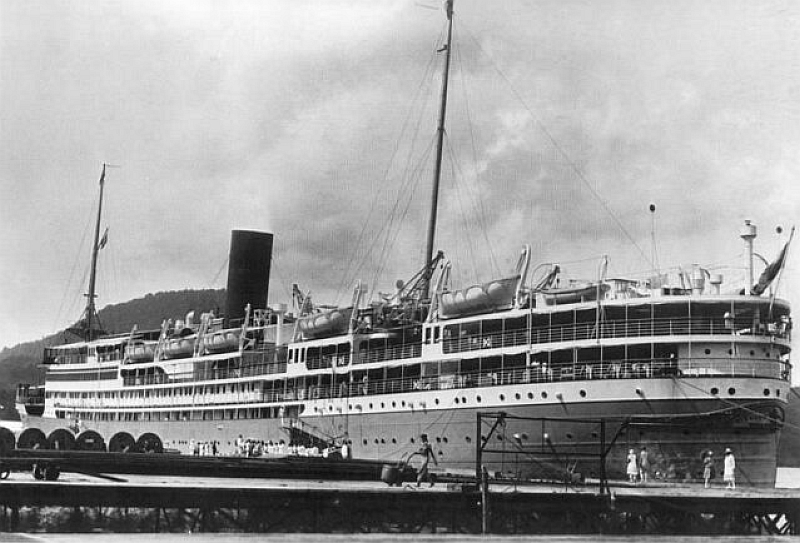
The
Sibajak is seen berthed in one of the Dutch East Indies
ports
Entertainment Today & Yesterday:
These
days when we sail on a ship, it will be a cruise, or even a line voyage from
Australia to the UK, or a Trans-Atlantic voyage, and whilst on board there is a
host of entertainment with a good number of bands, entertainers almost by the
dozen, movies out on deck or in a huge Cinema, a multi-level 600 to 1,000 seat
Theatre’s where there is on offer frequent high quality Production Shows.
Ships today offer every possible luxury, but back in the late 1920’s it
was nothing like that! There was one small band aboard and that was it, the
pianist from the band would play the piano at various times, as would the
violinist, the bass player was forced to play with the band. If lucky one of
them could sing. There were some organised games, but not a great deal
originally, that was until her Voyage ten! Thus finally RL came to realise that
they did needed to improve passenger amusements and thus they decided to
appoint a Games or Entertainment Director for the Sibajak, as they had already
done for their other ships. Thus, finally there would be some organised sports
programmes as well as more indoors entertainment programmes.
Captain Changes:
Captain
G.H.
Ruhaak was in command
for a number of voyages, but was replaced on Voyage fifteen by Captain
K.J.
ter Marsch.
It was during this voyage the Netherlands
Minister of Defence Mr. L.N. Deckers joined the ship
in Rotterdam
and he sailed all the way to the Dutch East Indies,
as he was heading there in order to inspect the Royal Dutch Navy and Army
there. Then in the second half of 1933 Captain Lap was given command of the
Sibajak.
But then came Sibajak’s
Voyage nineteen and this voyage would be a most unfortunate one for the ship.
On her way to the East Indies the Captain was given the order to drop two
passengers at Port Sudan.
While manoeuvring in the harbour, suddenly the Sibajak hit a rock and it turned
and it damaged the ship, as she was now taking some water in her aft section.
With divers checking the damage, the investigations proved that one of the
ship’s propellers were badly damaged, in addition there were several hull
plates that had been pushed in slightly, with a number of rivets being lost or
loose. The following day some necessary, but very temporary repairs were made
and late in the evening she was able to depart. She arrived at Surabaya
where the best facilities were available to handle her damage. However, it
should be noted that her temporary repairs made in Port Said did hold out
really well, although the ship did sail at a reduced speed, but having arrived
she was able to go into dry-dock where her damages were fully and
professionally repaired.
For her next Voyage number twenty, Captain
Slof
was placed in command of the ship. He had also been her Master when the Sibajak
undertook her very first cruise to Norway.
RL mail ships were regularly assigned to operate cruises, taking the
holidaymakers on a more leisurely voyage to interesting ports of call for
cruises from 7 days up to 14 days. Places visited would be; Scandinavia,
England,
Scotland,
Madeira and Italy.
Also, as part of the regular voyages to and from the Dutch East Indies,
tourists would embark and undertake short “Coastal Voyages”, such
as towards Marseilles,
to be followed by a separate trip along the French Riviera.
When the Sibajak left Rotterdam
for her 24th journey, the newly appointed Commander-in-Chief Home Fleet R.Nl.
Navy, rear admiral M.H.
van
Dulm
had embarked. In Dutch East Indies
the Dutch Eastern Fleet received him in grand fashion, which of course treated
the passengers to a magnificent spectacle.
Sibajak receives an Upgrade and new
Accommodations:
In
1935 RL decided that during her annual maintenance that the Sibajak’s
accommodation would be modernised with upgraded facilities as well as some
major alterations to be made to her Bridge and Sports Decks. Just aft of the
Captains cabin and lounge and other officer’s accommodations, the old
First Class Promenade Deck would be used for a new raised deckhouse that was
built and was extended as far aft towards the funnel as possible. This allowed
for twelve new First Class cabins, six twin bedded as
well as six single bedded cabins, but none of these cabins had private
facilities, this remained reserved to the two luxury cabins forward on A Deck
with their private decks. Upon completion her new tonnage was 12,226 GRT.
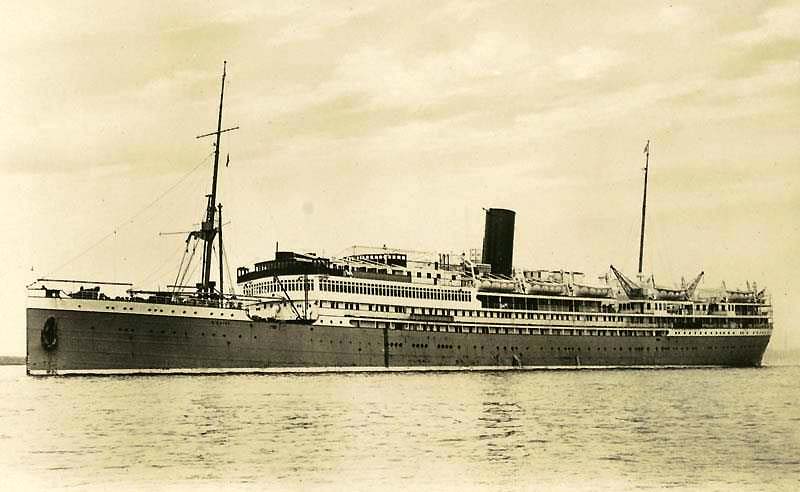
The
Sibajak is seen here directly after her refit her lifeboat configuration
remains the same, but her forward
upper decks has seen a in the Dutch change
New Passenger
Relations Introduced:
Considering
that the rather sad depressing thirties had faded away and times on board the
ship was gaining a much brighter feel and atmosphere. Passenger numbers
increased once more as did the transportation of car numbers and sometimes, in
fact at times there were so many, that RL was even forced having to park some
cars on Promenade Deck.
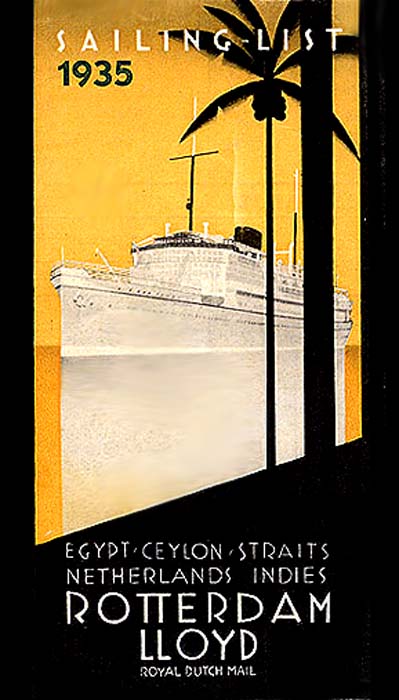
However
there were changes made whilst passengers were enjoying their long ocean
voyages, and RL pampered them as much as possible. Rotterdam Lloyd certainly
worked with new ideas of customer relations, and thus passengers were presented
with some wonderful small gifts, the like off “Silver covered refillable
lead pencils,” as well as fold away “Pocketknives”
and “Imprinted Pocket Calendars.” Birthdays were really upgraded
and besides a beautiful and delicious cake, the passenger also received special
attention from the Captain who would present the Birthday person with a very
special gift.
Further Voyages and Events:
In
1936 Captain
Slof
performed a rescue at sea by embarking the crew of an overturned
“Pirogue” being a large wooden boat off Colombo
harbour.
Considering there was the Spanish Civil War
going on the Sibajak did have to be very careful when sailing close to its
waters. Of course this war was in many ways the early signs of the horrors that
was coming World War 2. In fact as a special precautionary measure all Dutch
ships were escorted through the Strait
of Gibraltar
by Dutch war ships to ensure their safety!
However, the dangers of war continued to
increase rapidly and by 1937, war was very much expected. Dutch and foreign
ships altered their services and headed further east of the “Balearic Islands”
for safety sake! The Sibajak also had the privilege of Captain
Schoehuizen
in this year.
Jewish Refugees:
The
MS Sibajak headed to the Dutch East Indies,
towards to the conclusion of 1938, but this voyage had rather large numbers of
Jewish emigrants on board. Obviously this was because of the ever-increasing
racism in Nazi Germany and these people could clearly see what was going to
happen, but so many Jews could not believe that they were in danger, for they
would say, “But I was a decorated Officer in the last war, and fought for
Germany!”
Or I am an eminent scientist, or doctor, etc.” But later of course none
of these things mattered, for all would be sent to the gas chambers! But these
who could see what was happening sailed on this ship as they decided to
commence a new life in a new country, like Australia.
Again on the voyage departing Rotterdam
in March 1939 there were many Jewish people aboard, all bound for Australia
and all passengers enjoyed their time onboard, but did not realise that their
time in Australia
would be difficult if they were German citizens. But that is another story!
The 47th.voyage
commenced in June 1939 and this became what you might call her normal
“passenger Liner Voyage” before “World War 2”
commenced. During this passage the War erupted between England/France and Nazi
Germany.
Last Passenger Voyages as War is
Declared:
The Dutch Merchant fleet had been prepared for
the outbreak of war. Thus as the Polish invasion occurred on September 1, 1939,
all ships received cables in code with secret instructions on how to act. At
that moment the Sibajak had just departed Marseilles
bound for Dutch East Indies.
Just two days later on September 3, War was officially declared, although the Netherlands
was of course a Neutral Country.
When the Sibajak arrived in Colombo,
Sri Lanka
all the Jewish passengers were transferred to the P&O Liner RMS Oronsay,
which was in port and thankfully she was bound for Australia.
However, shamefully the British authorities there confiscated all the mail that
the ship was carrying and took the mailbags ashore for inspection. Once the
censor had studied the mail, it was given clearance and the bags were returned
to the Sibajak. Captain Schoehuizen although fuming,
but he was experienced as he had gone through World War 1, decided not to
protest against these disgraceful insolent British authorities, who had violated
the sovereignty and the Neutrality of the Royal Dutch State! But it was
recorded in his logbook and the British later had to apologise, for this ship
would be used by those who had violated it! Sibajak then continued to the Dutch
East Indies and disembarked her passengers and others boarded as usual, but for
obvious reason there were many less desiring to head to Europe.
Due to the outbreak of the war RL decided to change her registration to Willemstad,
Curacao.
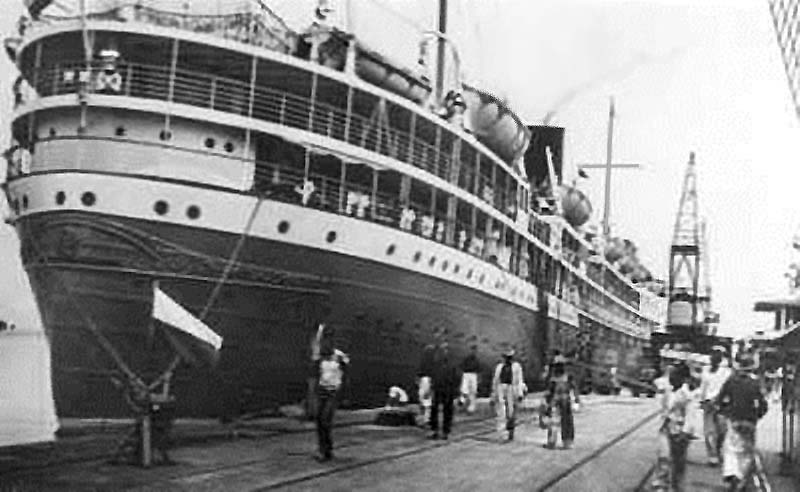
The
Sibajak is seen during 1939 in the East Indies bound for Rotterdam,
but sailing via Africa
Due
to the war in Europe, it was decided for the Sibajak to sail via Cape Town.
Then as she reached the English Channel
the lifeboats were swung-out in precaution, as well as “Paravanes” were in operation (a torpedo-shaped
protective device) to counter floating mines. Amazingly, the British Navy
detained the Sibajak to submit her to a thorough investigation. And once again
her mailbags ere removed ashore to be inspected. Once released with the mail
returned, the Sibajak arrived in Rotterdam
on November 15, 1939.
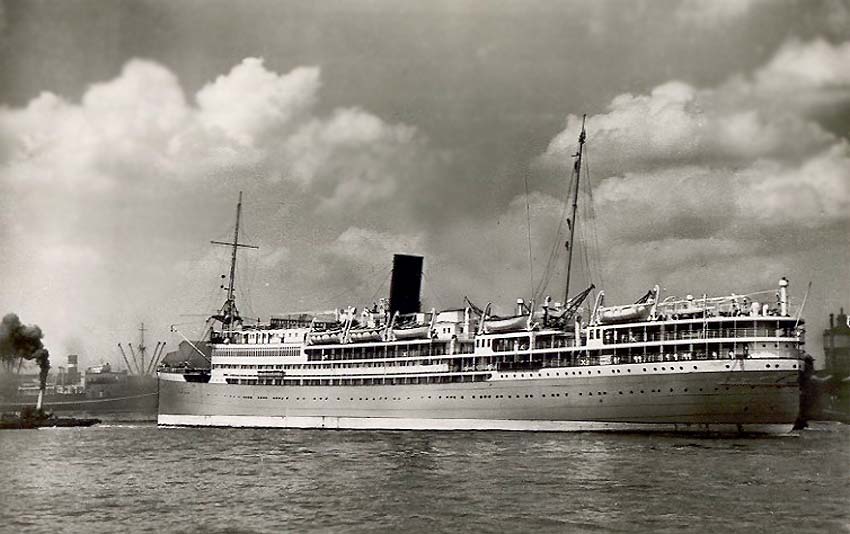
Sibajak
is seen arriving in Rotterdam
on November 15, 1939, the last time until after World War 2
At
the end of November This Dutch Liner from a Neutral Country departed Rotterdam
bound for the Dutch East Indies.
It had been decided that the large tug Zwarte Zee
would sail ahead of her, ensuring t a mine-free passage. But again as the
Sibajak reached close to Gibraltar
she was detained by an English destroyer, who again had her checked out. In due
course she was released and she sailed for Naples
where the majority of her passengers boarded for the voyage to the Dutch East Indies.
At the end of February 1940 MS
Sibajak departed Soerabaja bound for Rotterdam,
however due to circumstances with the war getting worse and worse, it had been
decided for her to conclude her voyage at Genoa,
Italy,
where all passengers disembarked. However, new restrictions meant that the crew
were now only permitted very occasional shore leave, but worse still was that
wives and family members were no longer permitted to come on board and visit
the crew.
Neutral Netherlands
Bombed and Invaded:
On May 10, 1940 the Nazis invaded the eastern
part of the Netherlands, but the Dutch fought back bravely, but it was also the
day that MS Sibajak departed Genoa and headed for the East Indies and
unbelievably she was packed with passengers and her cargo holds were the same
full.
What did this mean for her Crew?
This departure would mean a
great deal for the ships crew, although they did not know it as yet. Due to the
war having commenced in Holland,
for the crew it meant a long five years of service and not being able to see
their family or friends, but worse still sadly there would be some who would
never return home.
Then suddenly without any warning whatsoever
four days later on May 14, 1940 at 12 noon and for two and a half hours
non-stop, German bomber planes flew over Rotterdam and they literally bombed
the City Center flat with just the odd structure still standing, but they also
destroyed a number of ships in the harbour and badly damaging ships in
construction.

The
great Harbour City of Rotterdam seen after the tragic bombing by the evil Nazis!
Today
it is a great ultra modern city and an amazing city - home of “Hotel SS
Rotterdam V”
But
worse still, the bombing destroyed an incredible; 2,320 shops and department
stores, 775 warehouses, 62 schools and 24 churches were destroyed, as well as
24,978 homes making well over 85,000 people completely homeless! But that was
the material losses, but the human loss was far greater. Sadly they were never
able to obtain a total of actual number of lives lost, but it is estimated to
be between 890 to around 950 Dutch innocent citizens dead and thousands having
been wounded or seriously wounded to the point of having become disabled. But
regardless of the number lost, each one is very precious, and the Dutch
Government is well aware that there were many people that had come to the
Netherlands from the East in order to escape the Nazis most being Jewish and
some of these refugees who would have been in hiding would not been listed in
the local paperwork. Thus the numbers lost could sadly have been greater
However, during this dramatic
time the Sibajak being one of five Rotterdam Lloyd (RL) Passenger Liners found
herself located in Batavia.
The MS Slamat and the Indrapoera after the outbreak of the war were rapidly
chartered and commissioned by the British Ministry of War and fell under the
management of P&O. However, the Sibajak at the beginning of the war
remained under the control of RL.
With the Sibajak having arrived at Batavia
on May 16, 1940 she was laid-up for two months until July 14. Then she departed
from Batavia on July 14, 1940 for what was now her first “wartime”
voyage but official number 51 and she would be calling at the following ports
to the United States of America and back: Surabaya on July 16 to 22, Semarang July 23, Batavia July 24 to 29, Singapore July 31 to August 2, Balboa August 31 to
September 1, Cristobal September 1, New York
September 7 to 21, Baltimore September 22 to 28, New York September
29 to October 9, Cristobal October 15 to16), Balboa
October 16, Batavia November 15 to 23, Cheribon
(Indonesia) November 24, Semarang November 25,
Surabaya November 26 to 27, Balikpapan November 28 to
30) and returning to Surabaya on December 2, 1940. It is important to note
that she carried no passengers Batavia on July 29 to New York
September 7 1940.
She made one further voyage to New York
and departed on December 12, for Voyage 52, designated as a freighter bound for
New York
where she arrived on January 26, 1941. She returned to Surabaya
on March 31, 1941 being the conclusion of voyage 52.
Then in May 1941 she was chartered by
the British Ministry of War Transport and she departed Surabaya
and headed for Singapore
where she was converted into a troopship. Besides space for soldiers and
officers as well as some passengers, being mostly officials or high-ranking
officer families, she was also provided with arms. On her aft-deck a gun was
placed as well as machine-gun turrets were located atop the master’s
(starboard) and first officer’s (portside) cabins and these were the
ships main, although minor armaments. When completed, the HMT Sibajak had a
capacity to transport 2,300 troops and she was ready to head off to war!
On June 12, 1941 the HMT Sibajak sailed under
the builders instructions to the Naval Base. Whilst she was in Singapore Strait
and Selat Sinki her canon
and machine guns were given all given a good check over and actually the cannon
shot a shell into a safe area near by and the machineguns did a practice round,
thus the gunners made sure that all they were well equipped with their guns.
Also, that their shifts would know their positions as well as the guns they
would be handling during the many and long voyages in very dangerous waters!
When she arrived at Singapore’s
Keppel
Harbour
she took on board troops and a number of passengers.
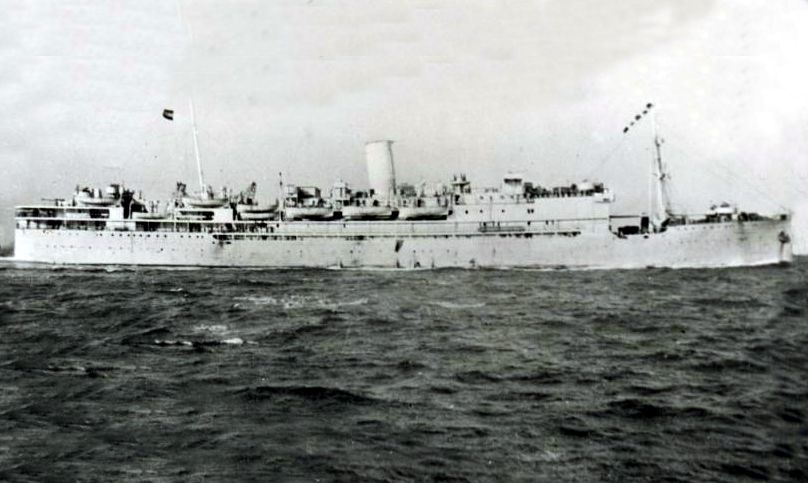
HMT
Sibajak is seen on a convoy from Sydney
to Singapore
arriving there on August 15, 1941
her aft gun can be seen located atop her aft deck
The
Sibajak departed on Voyage 54, being her first departure after her final war
preparations in Singapore,
and she departed on June 13, 1941 filled with troops, and headed directly for Durban
arriving there on June 28, all troops left the ship. Whilst here 825 troops
boarded and she departed Durban
on July 4, 1941 bound once again for Singapore.
The Sibajak arrived in Singapore
on July 19 and berthed at Shed 53 in Keppel
Harbour,
where all troops disembarked.
Thereafter the Sibajak commenced a six month
operation of voyages from Singapore
to Fremanthe,
Australia
and return, transporting troops known as “Convoy US11B”.
It was during HMT Sibajak’s first departure, with Australian troops
having boarded in Sydney she departed together with the following Dutch
troopships, the HMT Marnix van St. Aldegonde, HMT Johan Van Oldenbarnevelt and the Australian
liner HMT Katoomba, with the escort cruiser the
H.M.A.S. Sydney between Sydney to Fremantle and the H.M.A.S. Canberra between
Melbourne and Singapore arriving there on 15/8/1941. However it was during this
very first voyage that the convoy was caught in a severe storm, which caused
heavy damage to the cruiser H.M.A.S.
Sydney.
Her next departure from Sydney
again in convoy of course, was on September 17, and she again sailed via Melbourne
and arrived at Fremantle on September 25 and departed again on September 28
with further troops on board. She arrived in Singapore
on October 5, 1941.
She soon departed for her third voyage to Sydney,
Melbourne
and Fremantle and the latter two went very smoothly, unlike the first with the
massive storm in the Indian Ocean.
Then at the end of October 1941 the Sibajak
sailed for the first time to Liverpool,
England
sailing via South Africa
transporting the maximum number of troops she was able to accommodate.
Dramatic Changes in the Dutch East Indies:
Of course, by
now the United States
had also entered the theatre of war as they had been attacked when the Japanese
sent a mass of aircraft towards Pearl
Harbour
and bombed it severely destroying many naval ships and killing so many back on
December 7, 1941.
Sadly, the situation in the Dutch East Indies
dramatically changed for the worse for the Japanese came and attached the country
in January 1942 during what is now known as the “Battle of Manado.”
This great battle was a battle during World
War II which occurred at Manado on the Minahasa peninsula on the northern part of the island of
Celebes, known (today as Sulawesi, and it was a short
but a hard fought fight from 11 to 13 January 1942. The idea was to open a
passage in order to set up a suitable base from where to attack Australia
through the eastern part of Dutch East Indies.
Thus the Japanese forces landed on the east coast of Manado
on January 11, 1942 and defeated the small Dutch Garrison in the two days of
hard fighting in which half of the Dutch defenders were killed. However, the
Dutch did manage to successfully sabotage the oilfields before they were forced
to surrender. Other places captured either during these three days or within
several weeks were Tarakan, Menado,
Bali and Timor, placing the Japanese very close to Northern Australia!
Convoy WS.16 / WS.16B:
In February 1942
the Sibajak was made ready for a major Convoy protected by a large fleet of
H.M. warships, among which were cruisers as well as an aircraft
carrier. This convoy was the “WS” or as some called it the
“Winston Churchill Special” to Bombay.
Besides the HMT Sibajak in Liverpool,
there were another twenty ships registered in this convoy, not counting the
escorts protecting the convoy! However, although the majority were located in
Liverpool, others were at Clyde, Newport
and Swansea.
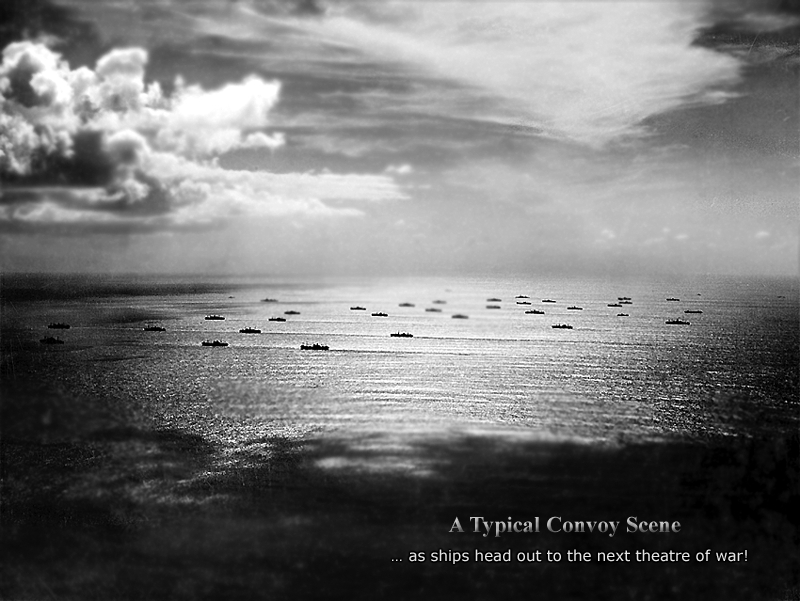
“Convoy
WS.16” & the Fleet sailing from the U.K.:
Then Convoy WS.16 departed Liverpool,
Clyde & Newport on February 16, 1942 but a few on the 17th. They arrived at
Freetown
at 6.30AM on March 1 and departed on March 6. The next port was Durban
where the fleet arrived on March 20.
However, ships that continued to Bombay
via Aden
received a slightly changed Convoy number from here, as it was now officially;
Convoy WS.16B.
This new convoy departed Durban
on March 25, “dispersed” off Aden
on April 6 and WS.16B arrived safely at Bombay
on April 8, 1942.
Convoy
WS.16 from Liverpool:
…….Awatea (NZ) - Troops.
………City of Lincoln - Stores - Feb 18 returned due to
shifting cargo, hull damaged by a tank.
………Cuba - Troops.
………Delftdijk (NL) - Stores.
………Denbighshire - Stores.
………Duchess of Richmond
- Troops
………Monarch of Bermuda - Troops.
………Mooltan - Troops.
………Sibajak (NL) – Troops.
………Strathaird - Troops.
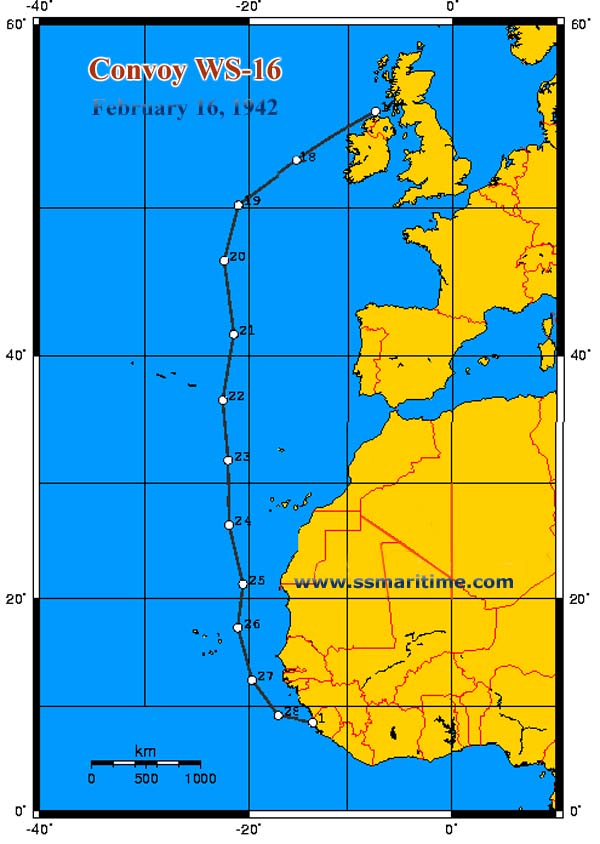 --
--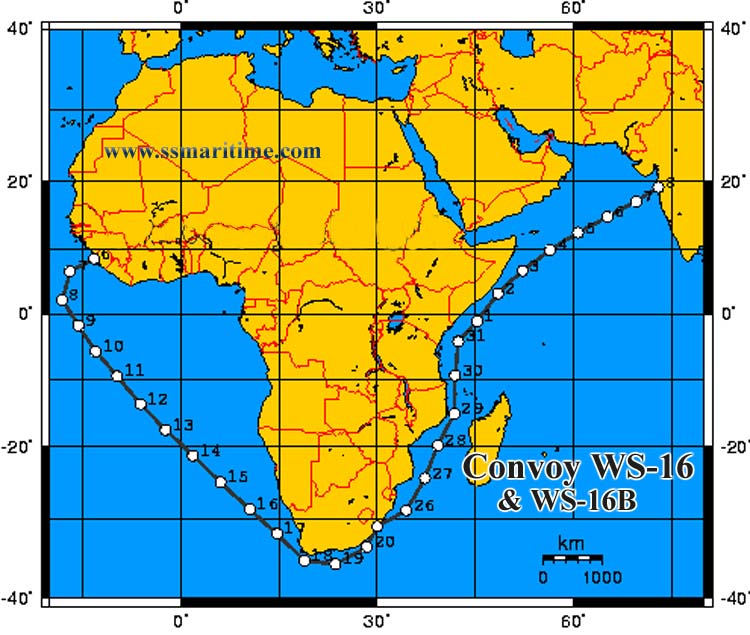
After
Convoy WS.16B the MS Sibajak has headed for and she was berthed at Freetown
(Sierra Leone)
on May 1, 1942 and the raids on the Dutch East Indies remained heavy on the
hearts of the Dutch crew, and obviously all knew that very hard times would be
ahead for all Europeans living in Dutch East Indies.
The Sibajak departed Freetown
and headed once again for Liverpool.
In Liverpool the ship was requisitioned on July 1, 1942 by the Kingdom of the Netherlands
for Holland
now had its government in exile in London.
She receives some further conversion, whilst her crew were sent to DEMS
gun-courses or courses for “Defensively Equipped Merchant Ships.”
Thereafter she sailed with Convoy WS.22 from
Liverpool to Cape Town,
besides other ships there were also four Dutch liners, the Ruys, the Johan
van
Oldenbarnevelt, the Nieuw
Holland
and the Boissevain. The California
was the Commodore-ship and the convoy was escorted by the cruiser H.M.S.
Aurora,
the auxiliary cruiser H.M.S.
Alcantara
and twelve destroyers escorted the convoy. Towards the end of December 1942 the
Sibajak returned once again to Liverpool
where the crew were allowed to enjoy a well-deserved term of leave. Next she
sailed around the Cape to Suez
with 2,500 troops on board.
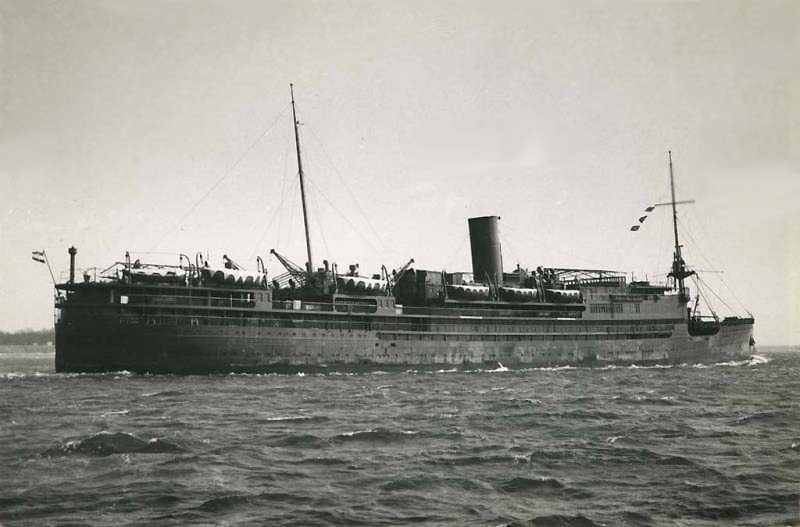
HMT
Sibajak seen around 1943, flying the flag of Curacao
since 1940
Then
in August 1943, whilst in Durban
harbour serious fire broke out on the ship in hold five. There was a problem,
as she had only just been fumigated and the fumes had not as yet been released,
this posed a problem for the fire fighters. It was a good hour and a half
before the firemen could reach the seat of the fire and were able to extinguish
it. There was considerable damage and hatches on the spar deck were burnt. But
as soon as the damage had been repaired the Sibajak departed and she sailed
finally again through the Suez Canal towards the Mediterranean.
After having called at Taranto,
Augusta
and Algiers
the Sibajak was at Glasgow
in mid-November 1943. But just a month later she sailed for a short voyage to
the Mediterranean region.
In February 1944 whilst in
Liverpool she once again made ready for another voyage to Bombay, after which
she returned to Liverpool around the end of May and the Sibajak was finally
installed with the latest Radar equipment. She then departed for a three-month
voyage to West Africa.
And with her duties completed there, it was in November that the Sibajak
departed, with Captain
Hamersma
in Command. She sailed via the Suez Canal to Bombay,
embarking and disembarking troops in several ports on the way there. Whilst the
Sibajak was in Basra
there was a very special occasion two American officers got married on board.
Sibajak then headed for Marseilles,
where around 2,000 troops left the ship and the Sibajak sailed for Naples
where she would enter into dry-dock for her major maintenance and overhaul.
With Sibajak’s
dry-docking completed, she sailed for Birkenhead
laden with troops and she arrived on March 30, 1945 and the troops disembarked.
Then finally came that great and wonderful day and all of the ships crew
celebrated VE-day with great exuberance, as they were in Liverpool.
But sadly, this did not mean that their work had ended and that the crew could
finally return home within a few days being so close by! Far sadly from before
all that, they had to operate another return voyage to East Africa and this
voyage concluded on November 1, 1945 in Southampton.
MS Sibajak Continues Repatriation
Voyages:
As the situation in the Dutch East Indies
was chaotic, for not only during the occupation the hatred towards the white
people had strengthened, thanks to the Japanese. The leader of the
“Indonesian “Liberation Movement,” its leader Soekarno, proclaimed a new “Republic
of Indonesia
on August 15, 1945, with himself as its President. The news of the Japanese
surrender trickled only slowly to all those who were still in the Japanese POW
camps. The main problem being that outside the camp-gates it was also very
unsafe and now their old enemy, the war-guards became their protectors. Tens of
thousands of men and women who had been for three years locked up under the
most terrible conditions now preferred to stay. Although most held onto the
hope of being repatriated to Holland as soon as possible in order that they
could recuperate to their normal self once again. But the repatriation began
very slowly and obviously priority was given to the seriously ill and to the
invalid.
During 1946 along an amazing 70,000
repatriates were able to board the Sibajak and other RL liners and head home to
the Netherlands.
In order to manage the massive task of the repatriation and also to make it
happen in an orderly fashion, the RL director Mr.
Th.
A.
W.
Ruys
headed for Indonesia
to organise an orderly departure for them.
Whilst in the Netherlands
a great amount of work had to be done for Rotterdam
harbour installations were destroyed during the original bombing, and waterways
had been blocked, in addition half of the Rotterdam Lloyd fleet had sadly been
lost during the war. MS Sibajak, that continued to sail in allied service, was
being prepared for another voyage to the Middle East.
Whilst she was berthed in Southampton
all of the Javanese crewmembers refused to perform their duties. There was no
doubt that during the entire war they had devotedly served on board the ship,
but suddenly they became insubordinate, that had much to do with the
proclamation of Indonesian independence and they were in fear that if the ship
would transport troops to Indonesia in order to fight there they would be the
ones in big trouble! The Javanese personnel were replaced and both the troops
themselves as well as the ship’s own Dutch crew carried the luggage on
board.
Sibajak then sailed for Bombay
where the military disembarked and a new assignment brought the Sibajak with
troops to Singapore.
It was on June 6, 1946 the British charter had officially concluded and the
Sibajak was officially returned to the Dutch Government and she was finally
repainted in her RL Livery! Looking very much like her old self again, she
departed for another voyage to Australia
calling at Fremantle (Perth)
and Melbourne
on September 16, 1946 and again she returned via Indonesia.
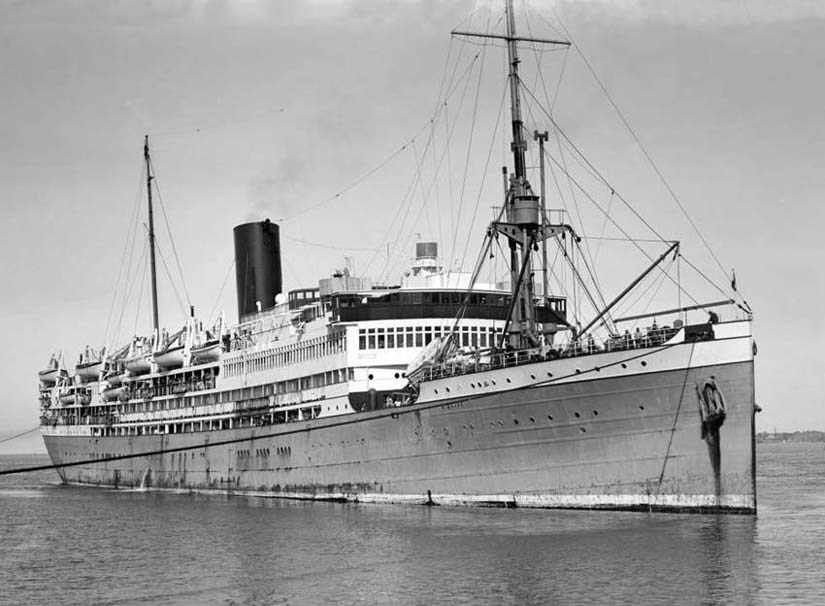
MS
Sibajak is seen here at anchor in Melbourne
on September 16, 1946,
her rushed hull paintwork has suffered considerably during bad weather
RL
Directors had already made provisional plans regarding the possibility that
should she survive the war, that obviously the Sibajak would have to return
into service as a Passenger Liner again. This would mean that she would need a
comprehensive reconversion from being a basic
troopship into a glamorous liner. But sadly she had to wait for a while as
there was more work for her to do post war, for she would continue
to transport repatriated persons and soldiers right through until 1950. For
example as I was advised; “The (Dutch) 3-7th.Regiment
Infantries was relieved and moved via Semarang to
Batavia to prepare for its repatriation on the MS Sibajak on November 29, 1949
arriving in Rotterdam on December 28, 1949.”
Between 1945 to 1950 the
Netherlands Government required the Sibajak as well as other Dutch Liners in
order to evacuate their citizens and other people from their ex threatened
colony and also to transport troops to the various theatres of war on the other
side of the globe.
In the decade following the Second World War,
many Dutch people attempted to obtain a booking on a passenger liner that was
able to take them to a new home and a new future in a new land far away. Each
week people from all over the country and from all sections of the population, hundreds
of new applicants presented themselves, with most desiring to go to Australia,
New Zealand
and Canada.
The main reason for the citizens of Holland
as well as so many other European countries desiring to look for a new life far
afield was mostly because there were so many
unemployed people due to the war as well as an extreme housing shortage. An
over-crowded Europe,
led millions of people into the search for a new future in other continents
where there was still plenty of space but more so “opportunity.”
The Netherlands Government signed “migration agreements” with the
relevant immigration-countries and entrusted the renowned shipping companies
such as the company which now had the Royal seal, thus it was Royal Rotterdam
Lloyd (RRL), Steamship Company Netherlands (SMN) and “Holland-America
Line (HAL) who combined had a remarkable fleet of ships.
On April 15, 1950 the Sibajak departed Rotterdam,
on what RL called the ships first official post war voyage, and she headed for Melbourne
Australia,
from where she returned via Indonesia
arriving on May 22, where she collected further repatriates and returned to Rotterdam.
On her next voyage she departed in July and visited Fremantle (Perth
- Western Australia),
then to Melbourne
arriving on August 24, and continued to Sydney
arriving there on August 26, 1950. She again returned via Indonesia,
which became sort of a routine for her until she returned to Rotterdam
in August 1951.
The all-New 1952 MS Sibajak:
Finally RRL sent the Sibajak to the Rotterdam
Dry Cock Company in August 1951 for one of the most extensive refits in her
history as she would now become a One-Class Liner. Her old third class
facilities were completely stripped and all the First and Second Class Lounges
and Dining Rooms were completely refurbished and updated, and a new lounge was
constructed under the old second class Sun Deck with a bar, a place I spent a
great deal of time with my new found friends during my voyage in 1958! But
sadly I have no photographs of this venue on an exterior one. The previous
third class Smoking Room far aft on Promenade deck became the new
Children’s Playroom. In addition all cabins received upgrades with
superior bedding, soft furnishings and other modifications. Upon completion she
accommodated a total of 956 passengers in the following accommodations; 598
passengers in 1, 2, 4 and several 6-berth cabins. 358 passengers in 5 medium to
large dormitories each having the following; 18, 34, 40, 128 to 138 berths. She
was completed on April 24, 1952 and she departed on her fist voyage as a One
Class liner four days later! MS Sibajak now had an official Registered Gross
Tonnage of 12,342 GRT.
Having been completed, the all-new MS Sibajak
was chartered to the Dutch Government, but she remained under RRL management
and she was to enter the United States
and Canada
service. She departed Rotterdam
of her first voyage on April 28, 1952 as she sailed for Quebec
Canada.
In due course she also visited also Halifax
and New York.
Having been to Australia
again the Sibajak headed for Indonesia
as in the past and on June 24, 1954 she departed from Tandjong
Priok
with a total 878 passengers and repatriates on board and she headed to Rotterdam
where she arrived on August 19, 1954. After this voyage she would make another
eleven migrant voyages in all!
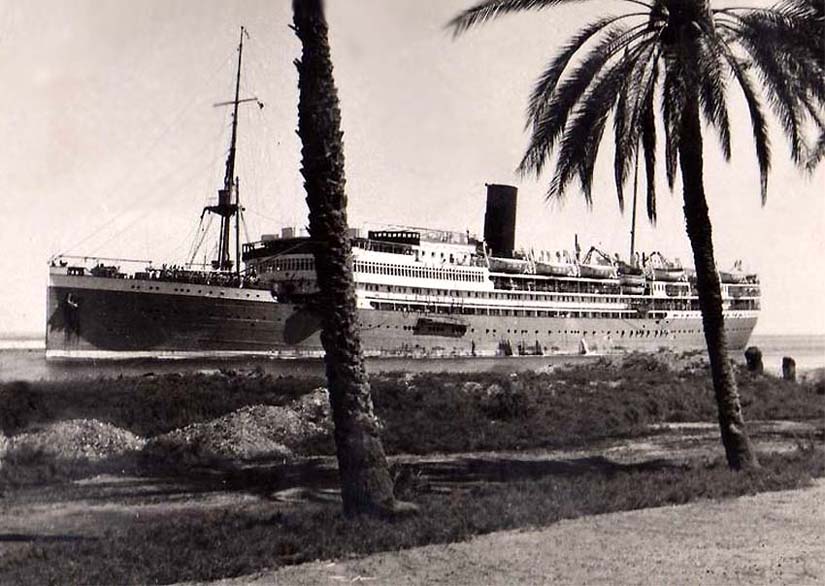
MS
Sibajak is seen transiting the Suez Canal in 1954 having been to Australia
and returning via Indonesia
Changes
in the Making:
Considering that the Government charter for
the ship would end in March 1957, Royal Rotterdam Lloyd commenced to make new
plans for the Sibajak as well as their newer and larger liner the MS Willem
Ruys in August 1956. Following the sharp decrease of the total volume of
emigration from Holland
to the various immigration-countries, the Dutch Government decided to end the
charter of the Sibajak.
After much consideration Royal Rotterdam Lloyd
and the Netherland Line (SMN) decided to enter their ships, including the
Sibajak into profitable service to destinations as Australia
and New Zealand.
To this end the company worked with agents both locally as well in Australia
and New Zealand
as they had developed new sailing ideas and schemes, with special fares. MS
Sibajak was now placed on the “Round-the-World-Service” (RWS) as of
October 1957. She departed Rotterdam
and then called on Southampton
to embark British passengers for the journey to New Zealand
and Australia,
or to return them having been in the UK
on a vacation, for Dutch ships had a fine reputation!
Round the World Service: Rotterdam, Holland; Southampton, UK; Willemstad, Curacao; Balboa,
Panama; Cristobal, Panama; Papeete,
Tahiti; Wellington, New Zealand; Sydney, Melbourne & Fremantle, Australia;
Singapore (occasionally Indonesia); Colombo, Ceylon (Sri Lanka); Suez, Port
Said, Egypt; Southampton, UK; Rotterdam, Holland.
My own voyage on the MS Sibajak in
1958:
I remember the day so well, that I and my
Mother boarded the Motor Ship Sibajak on a beautiful sunny day in Rotterdam
on Saturday May 17, 1958, bound for Wellington New Zealand.
However, my full story of the voyage on this fine ship and how she affected my
life is located on Page Three. Please see the INDEX at the bottom of this page.
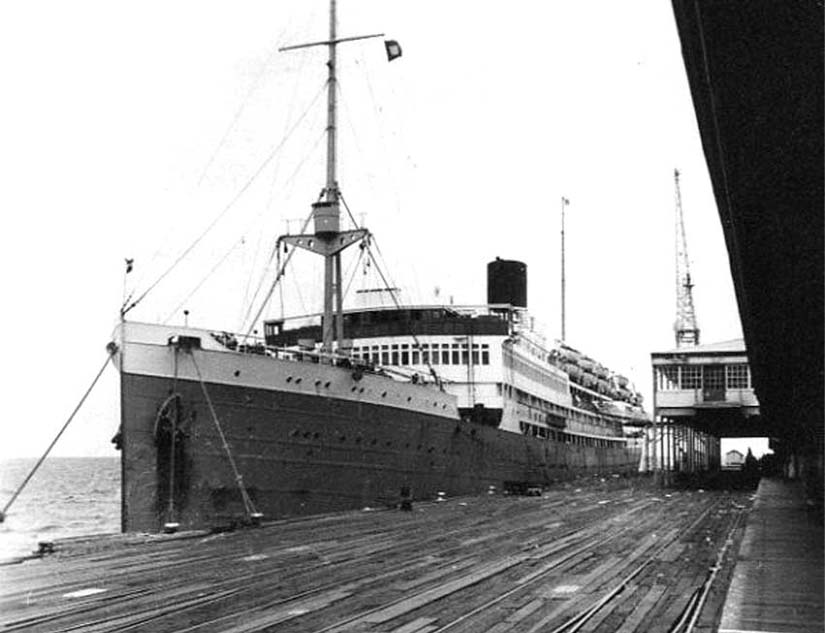
The
Sibajak is seen berthed at Station Pier Melbourne in 1958
with the blue Pieter flying, meaning she will depart that day!
Her
Concluding Year:
Director
Mr.
Ruys
of Royal Rotterdam Lloyd in October 1957 realised with Sibajak’s
old age, and her accommodation being so out of date compared to standards in
the passenger shipping industry in general, that a decision had to be made
soon. This came before the end of 1958 when RRL made an official decision that
the Sibajak simply could no longer compete with their other liner on the same
service, the glamorous and luxurious MS Willem Ruys. Thus a decision was made
that the Sibajak would be removed from the fleet in the very near future.
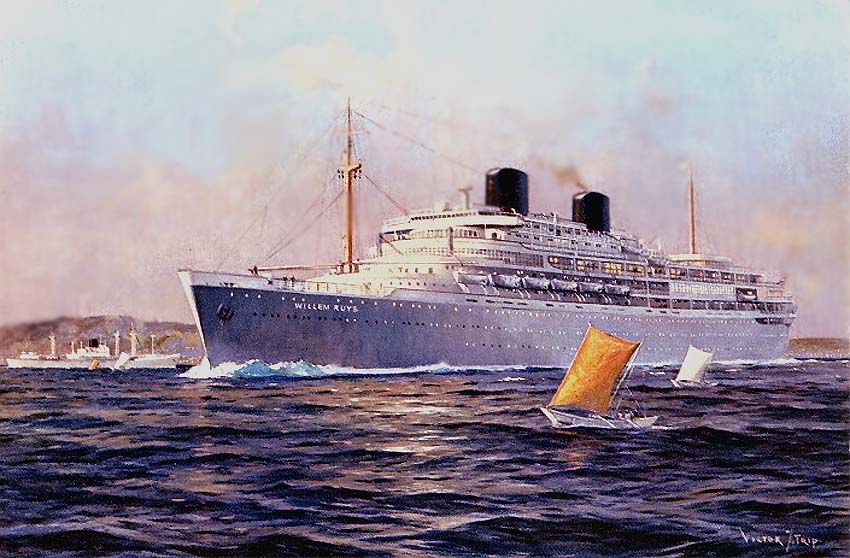
Above: The MS Willem Ruys completed in 1947 and the Sibajak sister
operated on the Round the World Service
Below: In 1965 this ship was sold to Italians and she became the
streamlined but ill-fated MV Achille Lauro
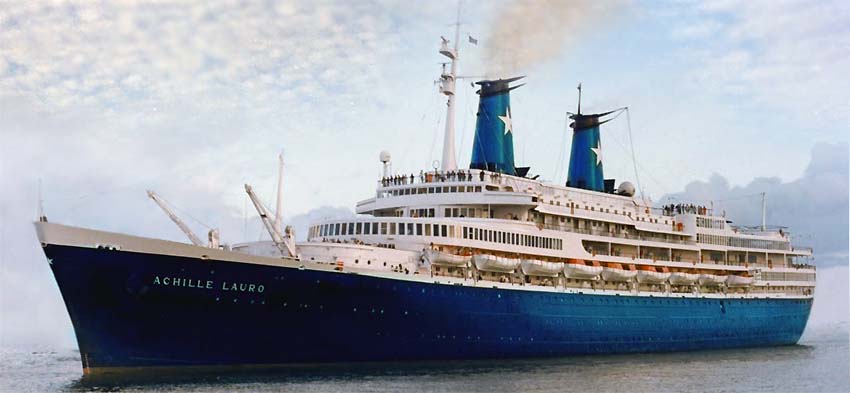
In
addition The Netherland Line (SMN) had the equally glamorous MS Oranje in
operation on the same service, she and the Willem Ruys were two class liners,
but Tourist Class was of an extremely high standard with beautifully appointed
lounges, spacious decks, both classes having swimming pools and so much more,
as well superior entertainments, that on the Sibajak!
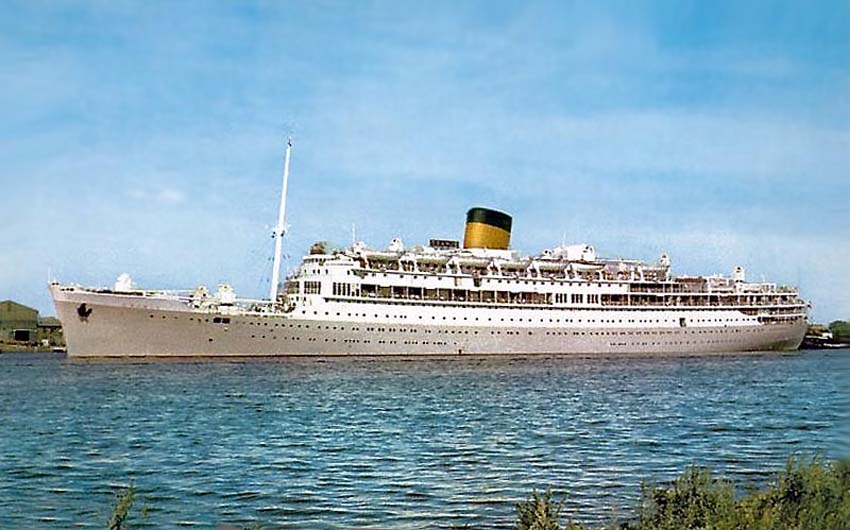
Above & below: The Netherland Line delightful MS Oranje, later Flotta
Lauro’s
MV
Angelina Lauro
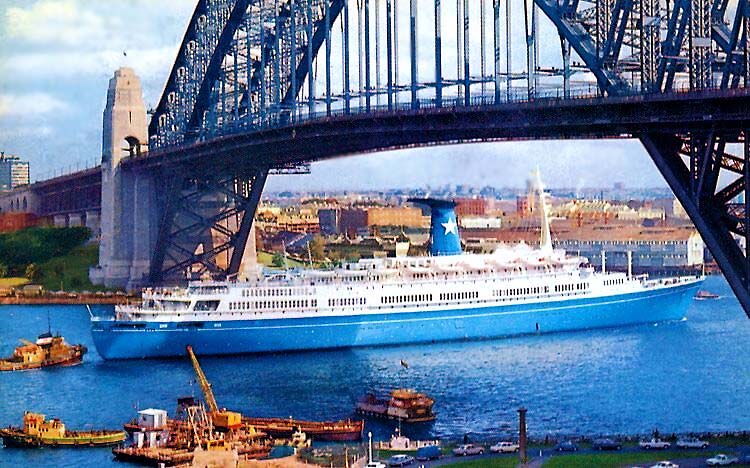
However
Royal Rotterdam
Lloyd
retained the Sibajak until an honourable and a profitable sale to another
company was possible, but nothing eventuated therefore RRL decided that another
option needed to be sought. The obvious option was to dispose her to a Ship
Breaker and an announcement was officially made through the appropriate
channels of “Lambert Brothers Ltd,” and in this manner RRL was able
to make known her availability to as many potential buyers as possible. However,
whilst awaiting any outcome, the Sibajak continued her scheduled services.
Although various offers came in, but all of these were rejected as the offers
were simply not sufficient.
Then finally in March 1959 an offer came in
for £180,000 (English Pounds) from “Chung Hing
Enterprise Company” of Hong Kong and considering this was the best offer
received to date, after consideration, RRL decided to accept it in April with
the agreement that the sale would be on the basis that she would be delivered
and handed over late August 1959 in Hong Kong.
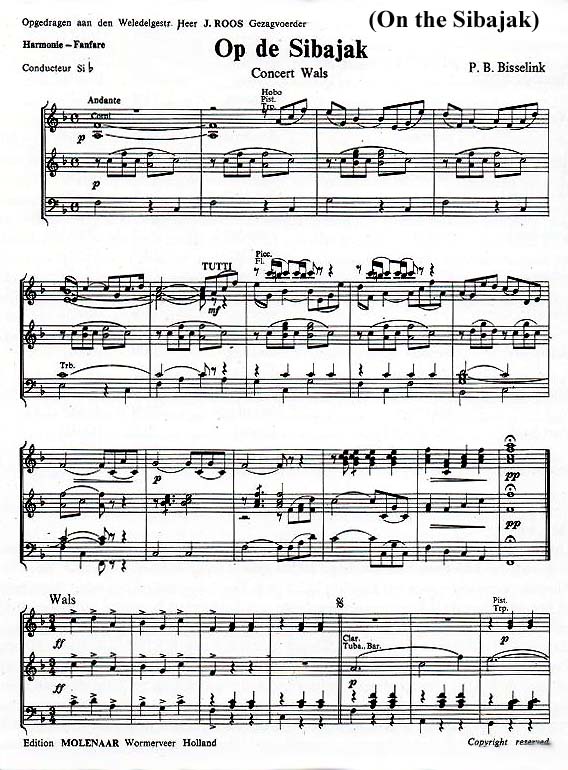
A
special piece of music written for the Ship; “On the Sibajak”
Obviously,
Sibajak’s final Voyage was carefully planned
for the company was well aware that there would be a good number of full fare paying passengers
who would wish to sail on her either on all or part of the way and thus being
able to keep the memory of this ship alive! There had been individuals who had
come by ship to Europe
and had either travelled around or visited family and they would take Sibajak’s last voyage as soon as it was announced!
Amazingly there was a small group who just took the short ride from Rotterdam
to Southampton, just to experience their experience on this ship, for there was
room as there were passengers’ embarking there. All other passengers
would conclude either in New Zealand
or Australia.
For the ship the end of the line was of course in Hong Kong
and for this difficult voyage RRL appointed the well-known Captain
J.
C.
Flach.
Amazingly it would be his very last voyage as he was due to retire and even the
ship’s longstanding butcher Pieter van Kessel
was in the very same situation, his last voyage and he was looking forward to
his retirement, but both felt sad to leave their much loved ship in Hong Kong!
On June 19, 1959 the RRL
management sent a memo to Captain Flach that Sibajak
would sail on June 23 and that;
“You sail via Southampton, Willemstad,
the Panama Canal and Papeete
to Wellington,
Sydney
and Melbourne.
From Melbourne
you sail via Surabaya
and Singapore
- for the disembarkation of (part of) the crew and for handing in stores (or
de-storing), to Hong Kong.
In Hong Kong
you will officially hand over the Sibajak to the
buyers, assisted by our agents Royal
Interocean
Lines" (RIL).
Thus when the Sibajak would
return to Rotterdam,
she would make final passenger voyage to New Zealand
and Australia
as she had been doing for some time.
MS Sibajak’s
Final Voyage:
MS Sibajak’s
Voyage 155 was boarding 739 passengers in Rotterdam,
with more to join in Southampton
some were bound for New Zealand,
but the majority for Australia.
As I already stated above, the ship was under the command of Captain
J.
C.
Flach
and he took her out and she departed Rotterdam
at 3.05 PM for the very last time ever on June 23, 1959.
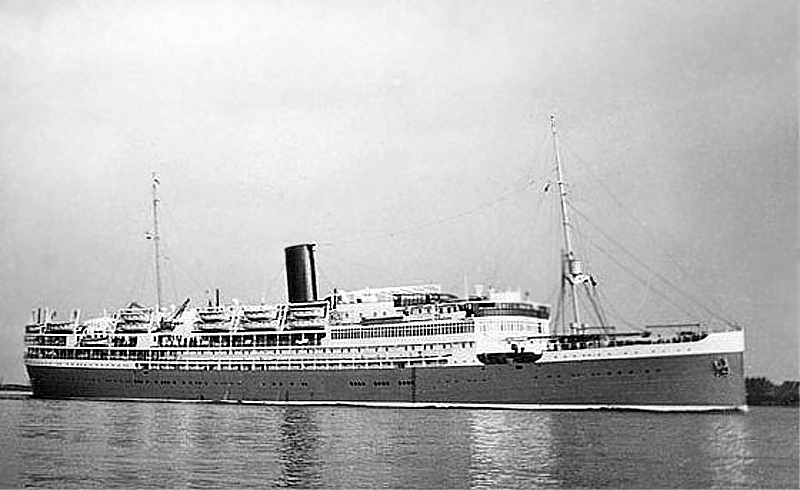
Here
we see the sad MS Sibajak still looking good during her final departure from Rotterdam
on June 23, 1959
Serving
aboard were 112 Dutch officers and 144 wonderful Indonesian Stewards and
Clerical as well as other Staff and those hard working 7 Chinese Laundrymen,
who did an amazing job!
Her first port of call was Southampton
she then sailed via her usual ports of Willemstad Curacao, Balboa Atlantic side
of Panama Canal.
She would then transit the Panama Canal
and make a call to Christobal on the Pacific side of
the Canal. She then sailed via the wonderful Pacific to tropical Papeete
in Tahiti and then to Wellington New Zealand
where her first passengers would disembark. She would then cross the Tasman Sea
to Sydney
Australia.
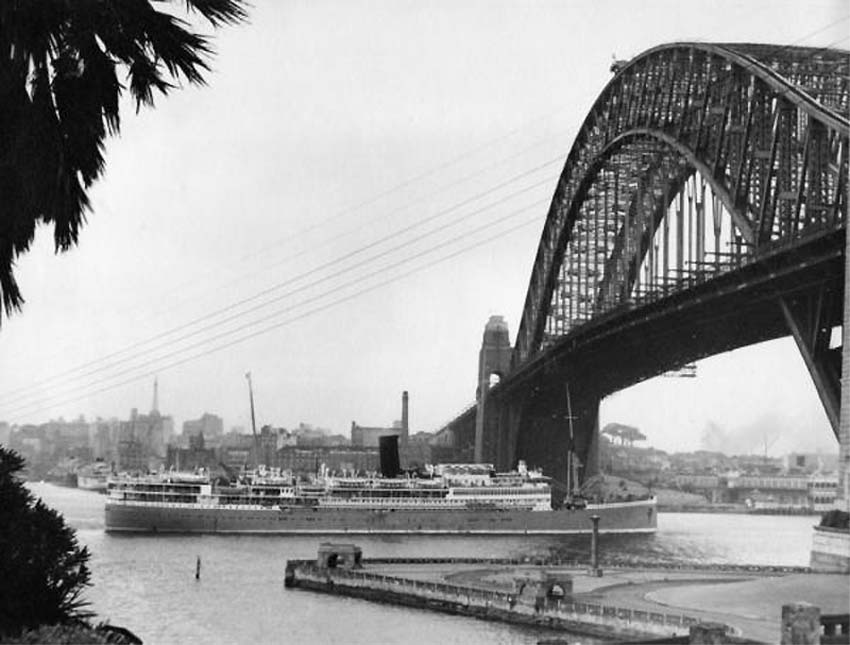
Above
& below: Sibajak arrives in Sydney
for the final time on August, 1959 with the media in tow
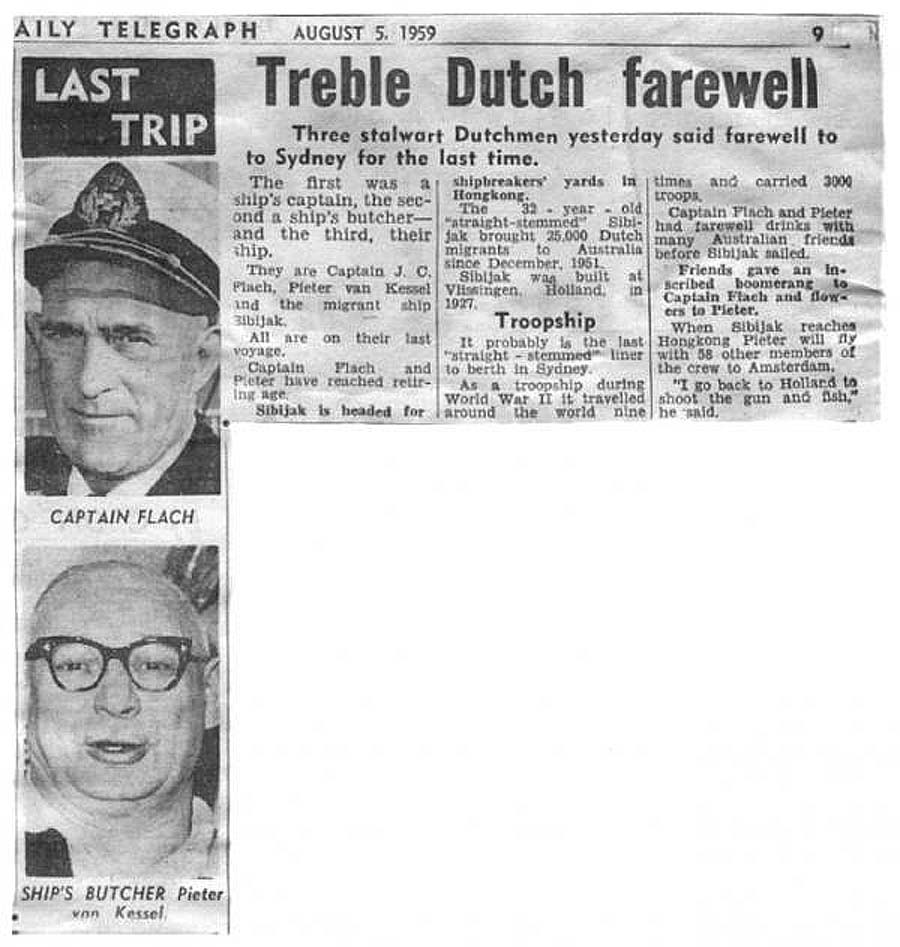
An
article in the “Daily Telegraph” on August 5, 1959
Sibajak
departed on August 6, and then she headed for Melbourne
arriving on August 8, being her final 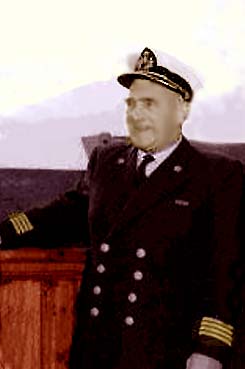 Australian port of call, but
also where her very last passengers
ever departed the ship! Once all passengers had left the ship, she departed
from Melbourne looking a lonely and deserted ship as she headed for Surabaya
(Jakarta) where most of the Indonesian, all the Chinese crews signed off. She
then headed via Singapore
where some of her Dutch crew officially signed off and the ship was completely
de-stored as per the requirements by RRL. Then the ship with a complement of
just 60 personnel headed for Sibajak’s final
destination - Hong Kong.
Australian port of call, but
also where her very last passengers
ever departed the ship! Once all passengers had left the ship, she departed
from Melbourne looking a lonely and deserted ship as she headed for Surabaya
(Jakarta) where most of the Indonesian, all the Chinese crews signed off. She
then headed via Singapore
where some of her Dutch crew officially signed off and the ship was completely
de-stored as per the requirements by RRL. Then the ship with a complement of
just 60 personnel headed for Sibajak’s final
destination - Hong Kong.
Here
we see Captain
J.
C.
Flach
on the Bridge wing of his beloved ship
the MS Sibajak during
her very last voyage to Australia
and Hong Kong
Handover to the
Breakers in Hong Kong:
It was early in the morning of August 25, 1959
when the Sibajak slowly arrived in Hong Kong, and the ship was rapidly boarded
by four security guards as well as three police officers for supervisory and
inspection purposes. They remained on board until the official handover four
days later, being Saturday the 29th. Most of her furnishings, fittings and
stores had of course been removed whilst she was in Singapore,
thus there was very little to remove from the ship in Hong Kong
before the ship was officially “Ready for Delivery.”
Early in the morning of August 29 the Sibajak’s Captain
Flach
received the authority for the delivery of the Sibajak from the Royal Rotterdam
Lloyd Directors and she was made ready for official delivery to take place at
noon on that same day. The representatives (Royal Interocean
Lines) of the purchaser and the Royal Rotterdam Lloyd, together with Sibajak’s Captain
J.
C.
Flach
signed her delivery certificate, which read;
“It is hereby agreed between Messrs. Chung Hing Enterprise Co. of Hong Kong, Purchasers, on the one
part, and the Royal Interocean Lines, Hong Kong,
Agents for Koninklijke Rotterdamsche
Lloyd N.V., Rotterdam, Sellers, on the other part, that the Twin Screw motor
passenger vessel “SIBAJAK,” gross 12,342 tons, net 6,935 tons, has
been delivered by Seller's Agents and accepted by Purchasers at 1200 hours on
29th August, 1959, at Hong Kong Harbour, in
accordance with the relevant Memorandum of Agreement, dated 6th April, 1959.”
And with the above, Captain Flach and his staff disembarked, but the directors of Chung
Hing Enterprises had invited the Captain and several
of his senior officers as well as several managers of RRL agents in Hong Kong,
RIL and they went to one of the finest Chinese restaurants for a farewell meal.
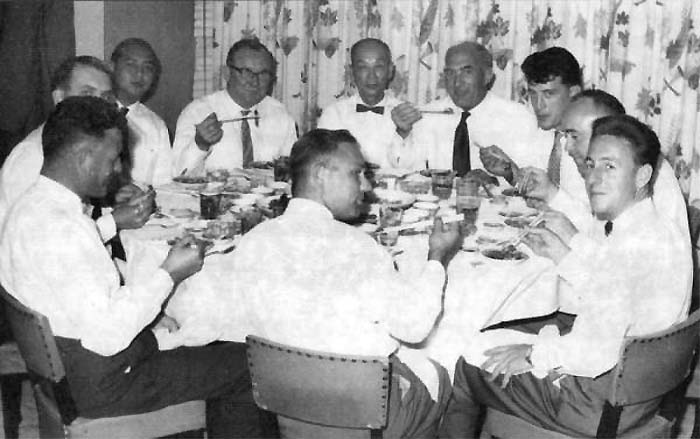
Captain
J.
C.
Flach and first
Helmsman, Mr.
C.
Muilwijk
with members of RRL and the breakers
As
we well know, Asians are very efficient and within less than a week the
breaking of the greatly loved Sibajak had began and she rapidly was broken up,
in fact from what I have been told that her breaking up was very much completed
in just four months, thus by the end on 1959.
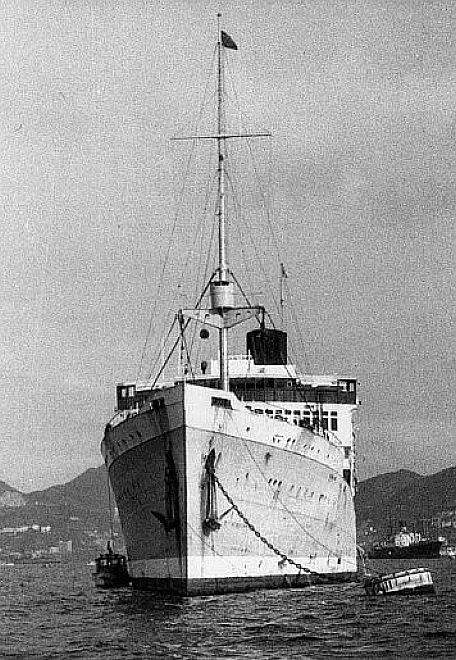
Here
we see the MS Sibajak laid up at the breakers in Hong Kong
on August 31, 1959
Photograph
by & © Mr. D Eijgendaal
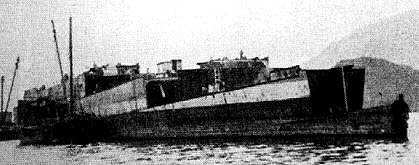
Sibajak
seen partially broken up in Hong Kong
late in 1959
Photograph
by & © Mr. G. Boot
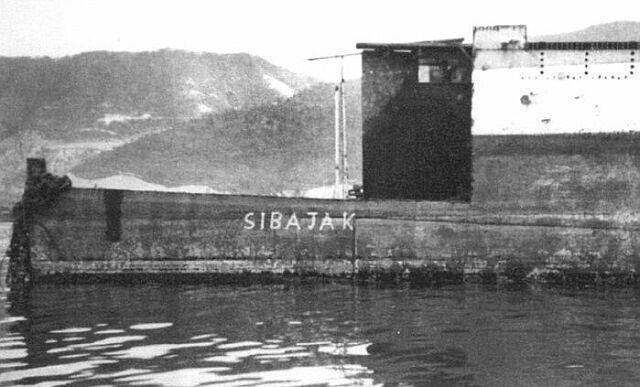
Here
we see what is left of her forepeak section with her name painted on the side
Photograph
by & © Mr. G. Boot
****************************
There is no doubt
at all that the M.S.
Sibajak will always be the …
“Grand
Old Lady" of the “Royal Rotterdam
Lloyd.”
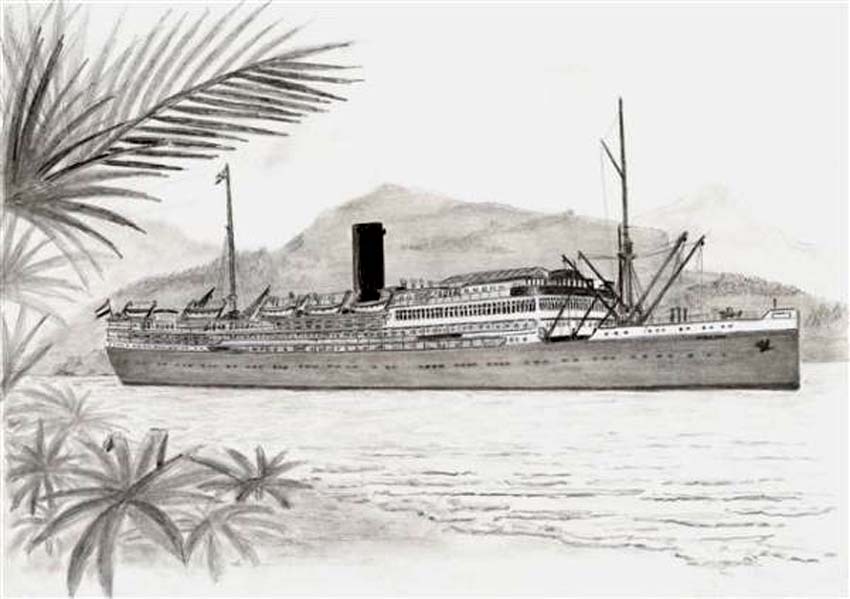
Remembering
the Glory Days of the MS Sibajak
A
delightful pencil drawing by Dutch artist Henk
Kuipers
Remembering
the M.S.
Sibajak’s
Glory Days!
It should be remembered that the M.S.
Sibajak
contributed greatly to the fame and the massive success of the “Koninklijke
Rotterdamsche
Lloyd
NV” also known as the “Royal
Rotterdam
Lloyd.” In her 31 years of service the Sibajak transported around a quarter
of a million passengers taking them half way around the world.
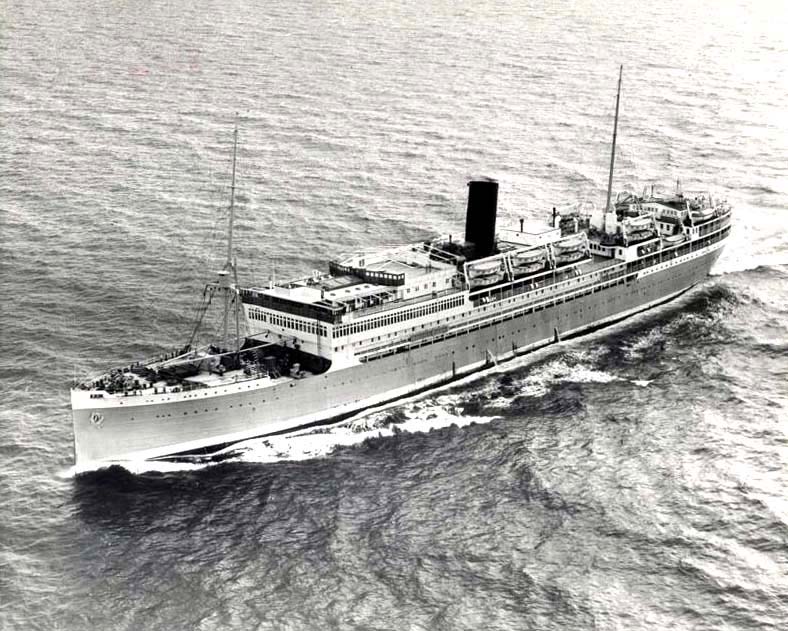
One
of my personal favourite aerial photographs of the M.S.
Sibajak
And
we should not forget during the Second World War she sailed an amazing 410,000
nautical miles (that is like her circling the Globe 19 times) and serving her
country well, although under the British, but with a Dutch crew, she
transported a total number of 75,000 troops to and from the many theatres of
war! In addition, after the War having received her major refit, she was
responsible for bringing well over 25,000 Dutch emigrants to New Zealand
and Australia,
not to forget the many from Southampton
as well!
And of course as I stated
earlier on this feature, I myself sailed on the MS Sibajak from Rotterdam
on May 17, 1958 and we headed for Wellington New Zealand.
There is no doubt at all that I will never forget this delightful ship that was
entirely responsible for my love of the sea and ships, and that is why I
decided that I would commence to work in the Passenger Shipping Industry when I
was young. Thus I commenced as an Office Boy and worked hard in the industry I
loved and I ended up as a CEO of a major passenger Shipping Company, then I
became a well-known maritime historian, author and lecturer. Thank you Sibajak,
for you changed my life as a young boy and shaped it into a most wonderful
Life!
Sibajak’s
Specifications:
Built at: De
Schelde, Vlissingen.
Yard: 181.
Call Sign: PSBQ
- 1940; PHMB.
Tonnage: 12,040
GRT - 1935; 12,226 GRT - 1952; 12,342 GRT.
. 7,087 NW (Net Weight) 8,289 DW (Dead Weight).
Length: 161.54m
- 529.11ft.
Breadth: 19.16m
- 62.10ft.
Draught: 7.82m
- 25.7ft.
Engines by: De
Schelde (Vlissingen)
Netherlands
Sulzer
Diesel
Engines.
Engine Type: Motor
Oil, 2-stroke single acting.
Cylinders: 8.
Power: 10,000
BHP.
Screws: Twin.
Service speed: Maximum
17 knots.
Passengers 1928:
454; 212 First, 174 Second and 68 in Third Class,
. Also 24 berths for Dutch troops.
. 1935:
525; 200 First, 250 Second and 75 in Third Class.
. 1950:
956; One Class.
Crew: 254
- In 1950; 489.
************************
MS Sibajak INDEX:
Page One: MS
Sibajak had long career from 1927 to 1959 - This is her complete story!
Page Two: Brochures,
Deck Plans, Photographs Menus and Memorabilia.
Page Two-b: The
Ships Interiors, Deck by Deck.
Page
Three: The Author’s voyage on the
Sibajak from Rotterdam
on May 17, 1958 - See Page 3b.
Page
Three-b: The Family Salden-Van Mulken sail to Australia
on May 17, 1958.
Page
Four: Ships Chef
H
B
Hulspas
story, a floor show programme and a farewell menu dated 1955.
Page Five: Family van der Net
and their voyage to Australia
in 1956.
Page
Six: Family van der Biezen
sailed on her second last voyage in 1959.
Page
Seven: The Nieborak
Family’s voyage to Australia
in 1959.
Page
Eight: Mr
& Mrs
Petzold
sail from Rotterdam
to Cape Town
on October 25, 1949.
‘Rotterdam
Lloyd’ INDEX:
MS Indrapoera: Completed in 1926 to 1957
and sold, sailing on to 1966. (Online Soon)
MS Baloeran: “ in 1930 and she was sadly bombed in
September 1943.
MS Dempo:
“ in 1931 and was
sadly torpedoed in March 1944.
MS Willem Ruys:
“ in 1947 and sold to
become the ‘Achille Lauro’
until 1994.
Also visit the two
‘Netherland Line’ Liners on the New Zealand - Australia
Service
MS
Johan van Oldenbarnevelt - MS Oranje
***********************************
“Blue Water Liners sailing to the
distant shores.
I watched them come, I watched them go and I watched them
die.”
Return to the ssMaritime MAIN INDEX
For interest: Sadly an email service to ssMaritime is no
longer available, due to the author’s old age and chronic illness as well
as being disabled, etc. In the past ssMaritime received well over 120 emails
per day, but Mr. Goossens can no longer handle the same. He sincerely regrets
this!
ssMaritime.com & ssMaritime.net
Where
you will discover over 1,435 Classic Liners & the 1914 built MV Doulos
Story
The Author has been in Passenger Shipping & the
Cruise Industry for over 60 years!
Please
Note: ssmaritime and associated sites are 100%
non-commercial and the author seeks no
funding or favours of any shape or form, never have and never will!
Photographs on ssmaritime and
associate pages are by; the author or from the author’s private
collection. In addition there are some images that have been provided by
Shipping Companies and private photographers or collectors. Credit is given to
all contributors. However, there are some photographs provided to me without
details regarding the photographer/owner concerned.
This notice covers all pages; although, and I have done my best to ensure that all
photographs are duly credited and that this notice is displaced on each page,
that is, when a page is updated!
ssMaritime is owned & © Copyright by Reuben Goossens - All Rights Reserved












-
 -
-
 -
-
 -
-









 --
--












 Australian port of call, but
also where her very last
Australian port of call, but
also where her very last 




